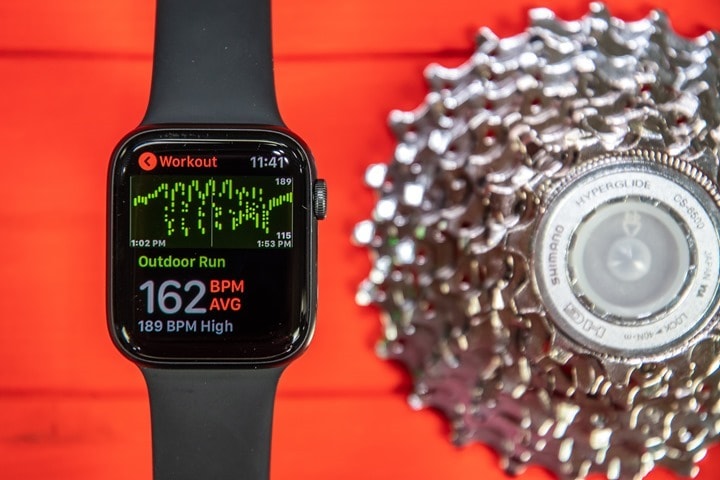
It’s been two months since the Apple Watch Series 5 came out, and the watch has been on my right wrist every one of those days. Swim, bike, run…and plenty more. You may remember my initial thoughts on it back in September after the first few days worth of workouts. Did things get better? And is it actually a better watch than Series 4 for sport and fitness? Back in September, the answer was a definite no. But with a pile of updates later, I kept on using it hoping that future firmware upgrades would resolve the issues I saw.
Now – before we get into the full review, let me just simplify what’s actually changed at the watch level from the Series 4 to the Series 5, since it’ll only take a second:
– Always-on screen added (and battery life reduced accordingly)
– New magnetic compass added
– Emergency international calling for LTE/Cellular editions
Now, in some ways that might be slightly misleading – because as part of iOS13 and WatchOS6, the Apple Watch (as a platform) got a bunch of new features. But virtually every previous Apple Watch also got those same features. Still, the stand-out ones are as follows:
– New ‘Trends’ tab on Activity app in watch
– New medical research enrollment app/functionality
– Standalone WatchOS app store (on the watch itself) – still requires an iOS device though
– Women’s menstrual cycling tracking
– Hearing health (monitoring loud noises/sounds)
– Live music streaming API’s
– Ability to add elevation as a data field for a workout
– Ability to use stop-watch mid-workout
– Better Apple Health summary information
Of course – only a handful of those actually related to sport and fitness (the title of this review). Still, some of those app bits are actually fairly notable. And they specifically fill in some serious gaps that Apple has had in competing at the end-user level against the Fitbit and Garmin apps (things like better reports/trending). But, we’ll get into all of that a bit later.
Finally, as always – I note the source of my device. Which in my case was simply me pedaling down to the Apple Store and buying it myself. I’ll continue to keep this unit for various tests over time, though, my wife also bought one which we returned after she decided it didn’t meet her fitness/sport requirements (more on that later too). So, let’s get rollin’!
Unboxing:

The Apple Watch Series 5 unboxing ‘experience’ is virtually the same as the Series 4. Which isn’t a bad thing, because that’s an awesomely designed box. It opens up like a flower in front of you, showing all the goodness that’s inside. In this case, I did the photographic unboxing of my wife’s watch, since I did my watch via video instead. No double-unboxing cheating on this post!
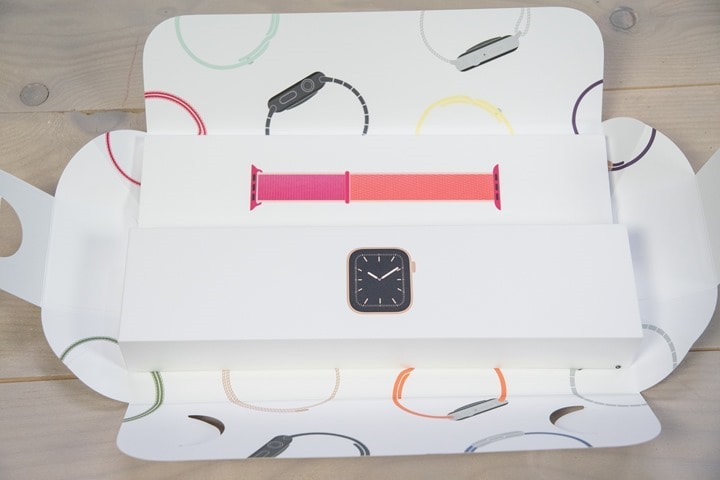
Inside you’ve got the strap on one layer, and the small watch pod on another. The pod sits next to the Apple Watch charger and wall plug. Those also remained unchanged since the original Apple Watch.
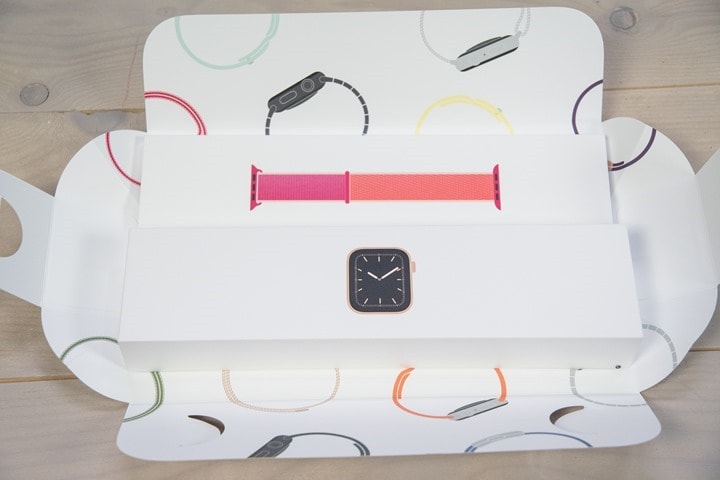
Here’s a closer look at the pod in its small fabric home:
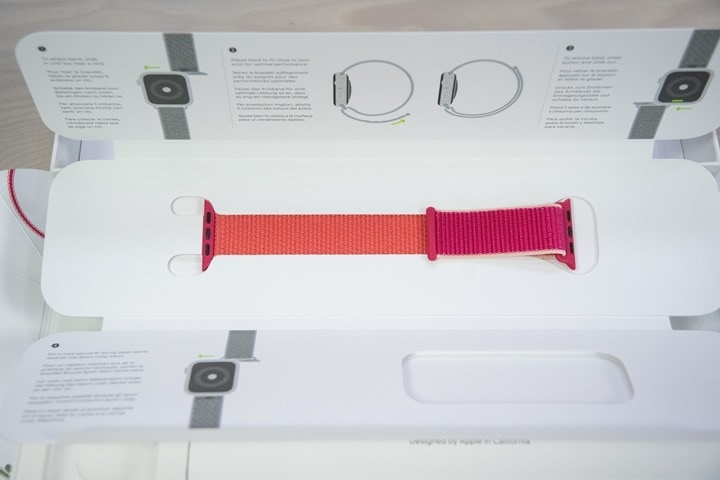
And then the standard USB wall charger plug. In my case, an EU plug because I’m in the Netherlands, but it’ll vary based on what country you’re in.

And then the charging cable:


After that, we can slide the watch out, and attach it to the straps.
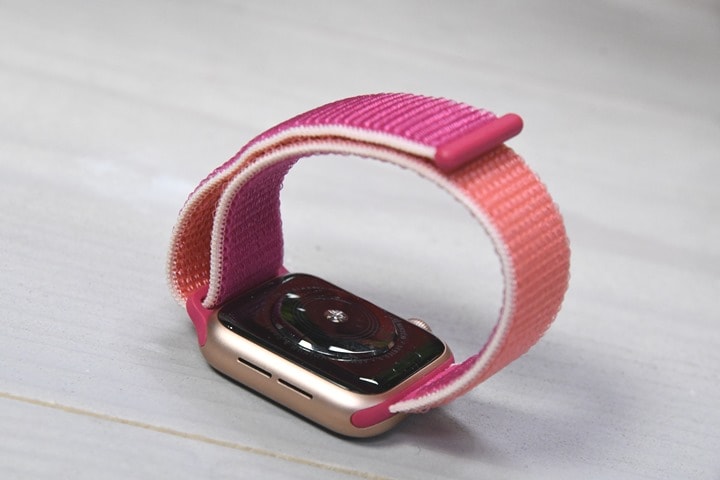
Switching to my main watch, here’s the removable straps. This allows you to buy other Apple Watch straps and simply slide them in easily.
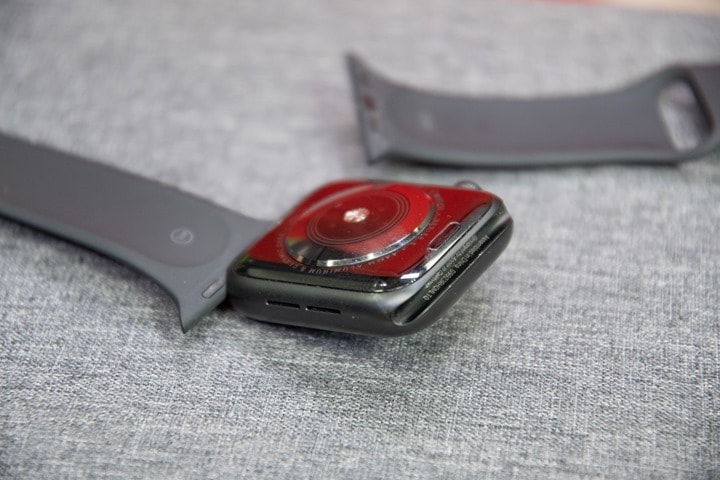
The Apple Watch comes with two different sized straps – a smaller one and a larger one, so it’ll fit most wrists. Finally, if you’re curious about the display sizes of the variants (40mm and 44mm), here’s those side by side:
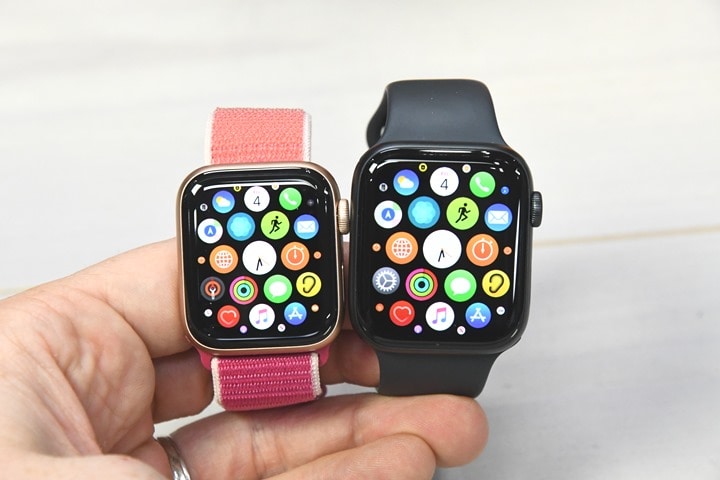
And that’s your extensive unboxing in a nutshell.
The Basics:

Let’s just dive right into the biggest and most obvious change you probably already know about: The always-on screen.
Apple joined basically everyone else this fall in offering an always-on screen. For example, Samsung’s had it for a while. Then Fitbit and Garmin both offered products with it within a few days of each other. In the grand scheme of watches, what Apple’s done isn’t really terribly different than the others. They’ve traded battery life for an always-on high-resolution display. They tweak the refresh rate on that screen depending on various circumstances to assist in battery life.
However, no matter how you slice it – Apple’s battery life timeframes are the worst of the bunch. While things were super-bad when the Series 5 first released (I couldn’t even make it to the end of the day), now I’m roughly able to get from wake-up till early into the next morning (assuming no massive GPS workouts). Still, compare that to the Garmin Venu where I get a solid 2.5-3 days with always-on, and the Fitbit Versa 2 that’s in roughly the same ballpark.
However, I’d easily point out that the Apple screen is far clearer, and also better at subtlety – primarily night-time. With a newborn ‘released’ just a few days after the Apple Watch released, I’ve spent many a night awake in the dark. Even on their dimmest setting the other watches are still beacons – whereas the Apple Watch display is incredible at night at not being a beacon.
But again – there’s trade-offs. The Apple Watch always-on display doesn’t work for any 3rd party apps (and even some Apple native apps). It just goes fuzzy, like this – you can see the time is shown, but the underlying app is fuzzed out:
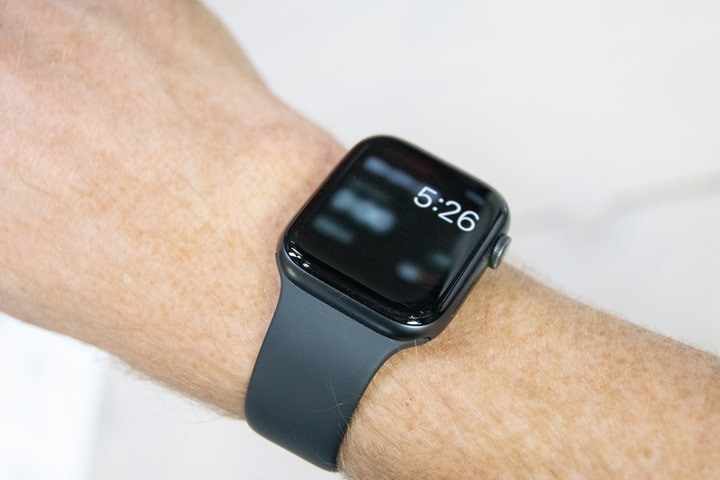
And there’s no announced plans from Apple to change that (whereas Garmin and Fitbit can use always-on all the time). The nearest timeframe we’d likely see any changes there is next summer after WWDC.
So let’s set the screen aside for now. The rest of the exterior of the Apple Watch Series 5 is virtually indistinguishable from any other past watch. There’s still just the two physical buttons. One in the lower right corner, and then the digital crown that can both rotate and be pressed in.
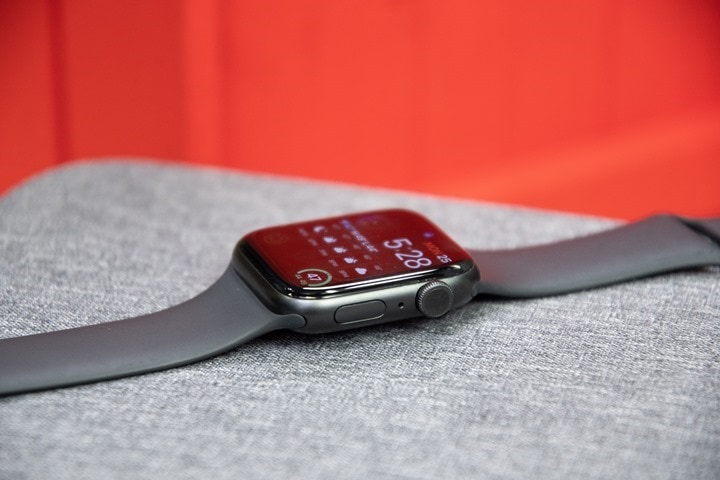
These buttons along with the touchscreen that kinda works with gloves form the entirety of your interaction experience. Except for voice commands, for which you can use Siri. Fitbit introduced Amazon Alexa in the Versa 2, though, it can’t speak back to you. So it’s kinda a bit of a mute.
When it comes to customizing your default watch face, Apple gives a pile of options. But unlike every other company, there’s no method to use 3rd party watch faces. Essentially saying: If you don’t like what’s there…get a different watch. It’s an approach I’ve always found bizarre given how strong Apple’s app ecosystem is otherwise.

Below are some of the faces in the gallery. For the most part, while there is differentiation, they kinda all have much the same feel to them (with many simply having tweaked variants). Again, there’s nothing 3rd party in here and you can’t make your own.
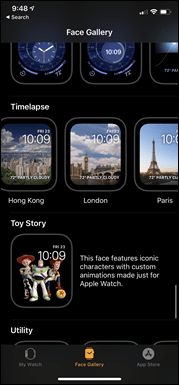
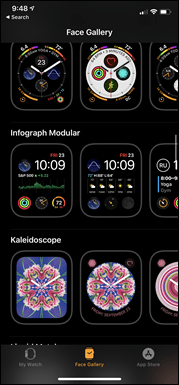
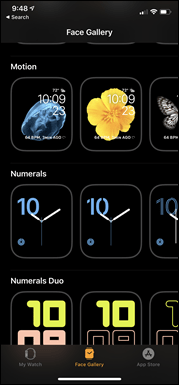
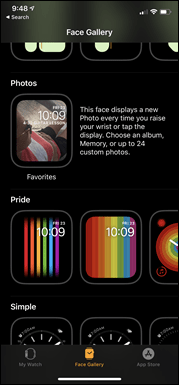
However, we see that same watch-face stubbornness on display in other areas. For example, you actually can’t add ‘Steps’ to your watch face. A bizarre omission that literally even $15 watches at Walmart have these days. You can technically find 3rd party complications (that’s the term for the small bits of information you can place on the watch face), but those have additional limitations on refresh rate (plus you have to buy or add the app). In fact, this was a core reason why my wife ultimately returned her Apple Watch. She wanted steps to display on it, with a daily step goal in mind during pregnancy.
For as many other complication metrics on the watch face as there are (for example UV strength), how there’s no simple step count option is mind-boggling.
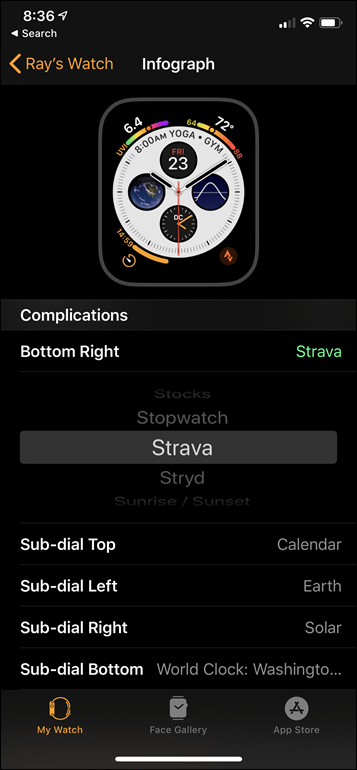
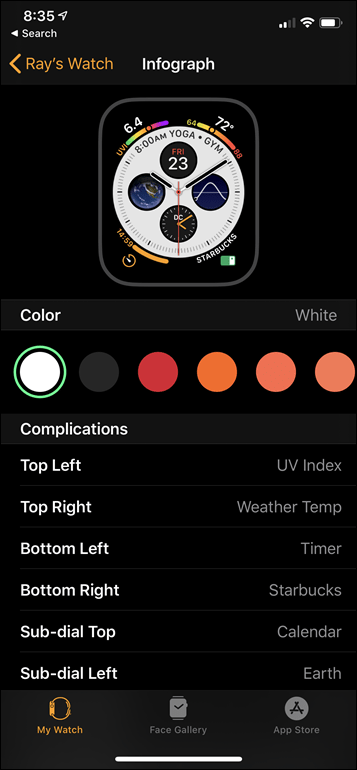
Now, this may sound like I’m nit-picking. And perhaps I am. But this is a sport and fitness review. Not a ‘is it a good all-around watch review’.
Because if it were just a general review I’d tell you (as I have since the original Apple Watch) – that Apple makes *by far* the best all-around smartwatch. The nuance of everything on the watch is super smooth, especially the haptic engine (vibrations), but also now the display brightness. None of that’s changed. It’s still fantastic there. But it’s also lagging from a fitness standpoint.
As for apps, these are largely managed from your phone within the ‘Watch’ app. For the most part, your regular phone apps have corresponding watch apps. Most of the time it’s little more than glorified notifications, but occasionally you’ll find some good nuggets in there.
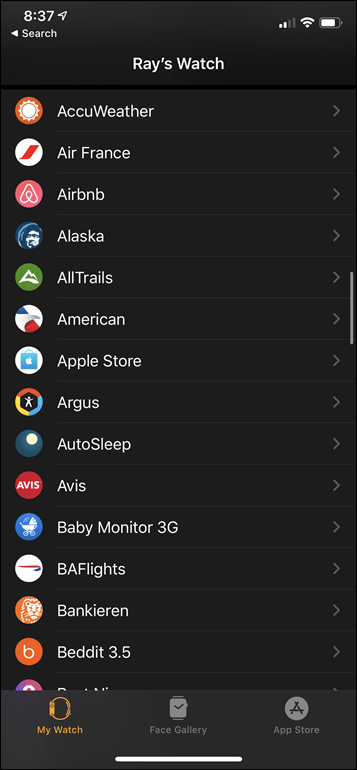
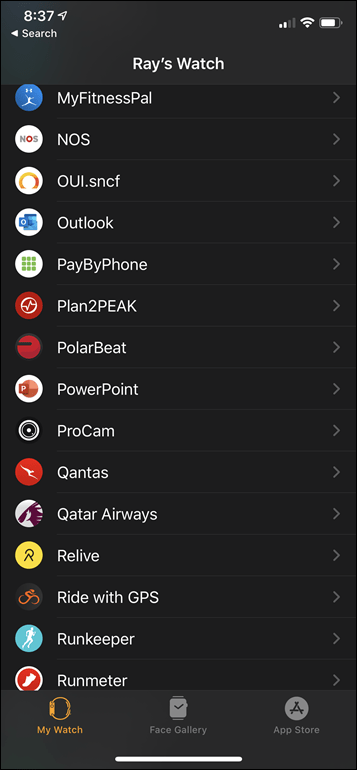
Still, the trend in 2019 was definitely not expansion of watch apps. In fact, we’ve seen and heard some big names decide to stop actively developing Apple Watch apps, noting that people just end up using their phone instead. And I think that’s definitely true across the board – not just Apple. Wearable apps, in general, are often incredibly niche-focused. They ideally solve a very hyper-specific problem where it wouldn’t be faster to reach into your pocket to grab your phone. Or, where taking/using a phone is impractical (like, surfing). Or – oddly enough, fitness apps (which we’ll get to). For everything else like reading the news, grabbing your phone just works better.
When it comes to activity, Apple uses a three-color ringed approach to monitoring your daily activity levels. These rings have daily goals, and complete a circle (ring) each time you achieve that goal. For example, the blue standing ring is goaled by default at 12 hours of standing. Which means you need to stand once every hour, ideally 12 hours of the day. The pinkish-red is for ‘Moving’, and the green is for ‘Exercise’.
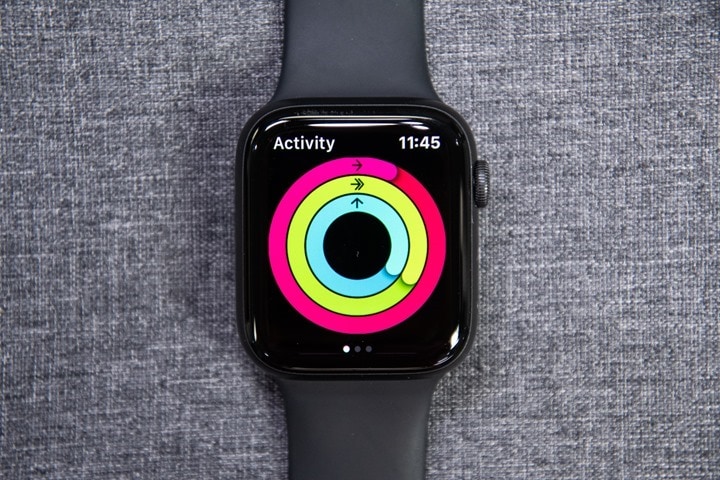
You can swipe down on this watch-face to see how it has trended over the course of the day:
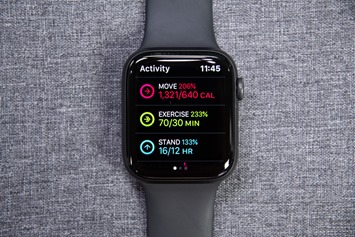
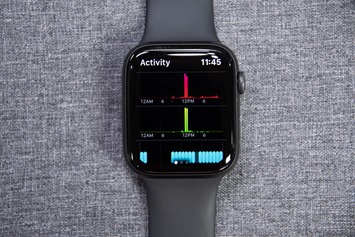
And then all of this is available on the companion app – called ‘Activity’ on your phone:
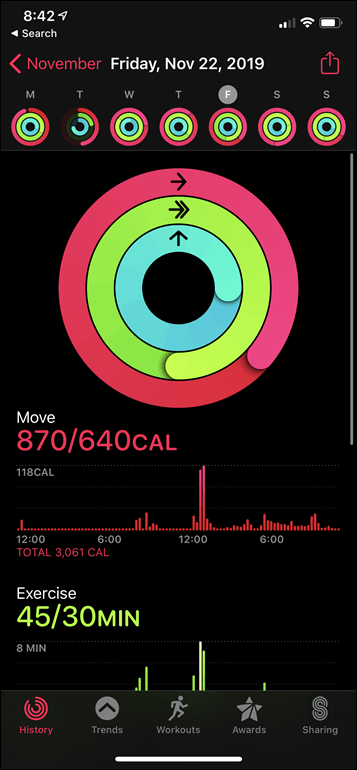
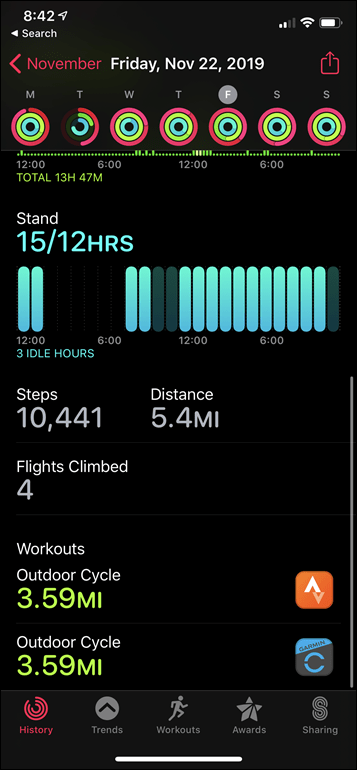
In fact, one of the new areas on WatchOS6 is the addition of a trends tab. This tab is supposed to tell you trending information about your health stats. Except, it doesn’t activate until after *6 months* of usage. For real, it even says so on Apple’s Support site:
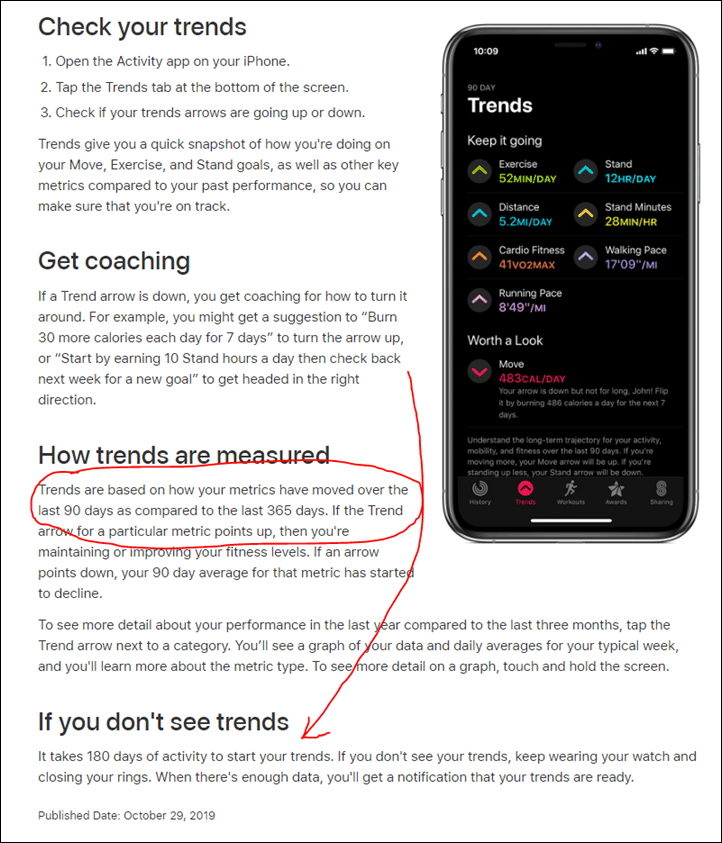
So, despite wearing the Series 5 for now exactly two months, it’s still blank (we’ll ignore the fact that for running pace, it just picks random-ass numbers):


Which is frankly unacceptable. There isn’t any algorithm math here when it does work. It’s just showing you basic graphical trends according to Apple. Why on earth do I need 6 months of data for this? Every other company in the space is able to show this type of information near immediately.
Sure, I totally understand that after a longer period of time the data gets better – the trending gets better. But 6 months is laughable. I can’t think of anything in the fitness world that says you need to wait 6 months to see *any* data. Can you get longer-term trends in 6 months? Again, of course. But you can also get perfectly usable trending in even just a few weeks. After all, Apple’s own ‘Activity’ app on the watch reminds you of this daily with streaks and such. Plus, if you tap into one of these, you can see it has all the data just fine:
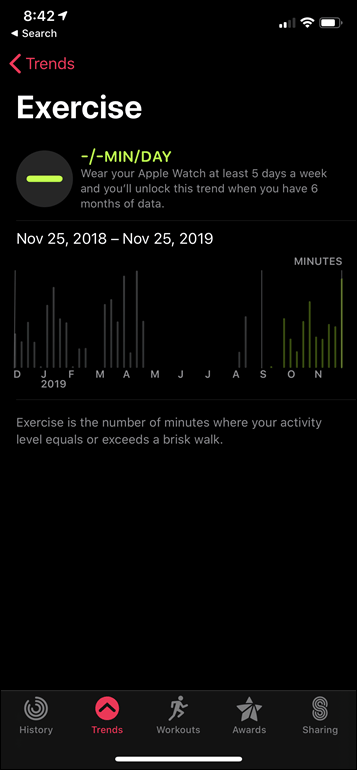
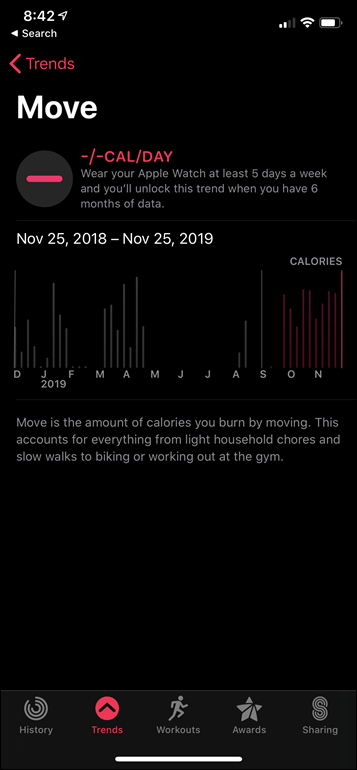
Now, despite the Activity app falling short here – Apple also updated the ‘Health’ app too with iOS13. Historically that’s been more of a database of your health data than a great place to get glanceable information. While all of the data is still there (and easily accessible), the app now has much better access to some of these overarching summary ideas and trends:
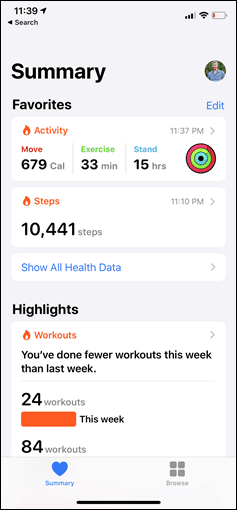
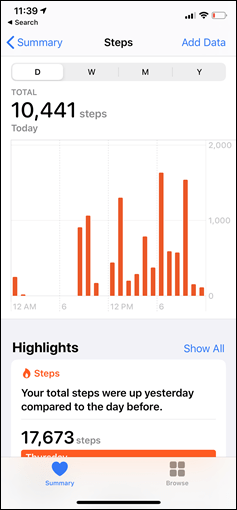
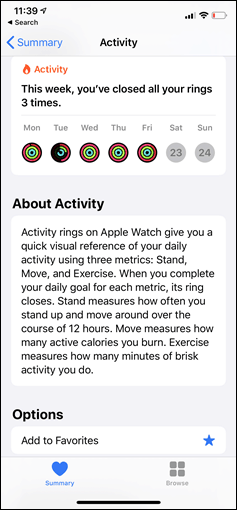
In any case, back in the Activity app, the next tab you have is workouts, but the entire next section is dedicated to workouts. So we’ll skip to ‘Awards’ – which shows you various badges you’ve earned over time. In my case I have a fun collection of badges I earn roughly each fall when I start wearing the Apple Watch for my annual reviews. Sometimes I’ll dive back into it at various points throughout the year in between other reviews.
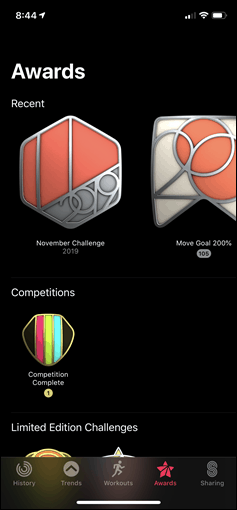
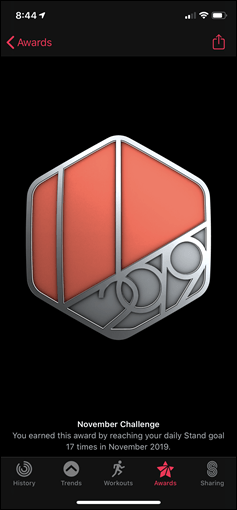
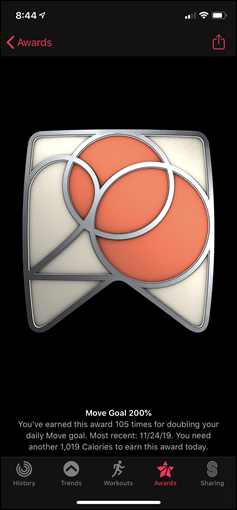
It’s on the next tab (Sharing) that you can share your data with friends and compete with them. In my case, I don’t have too many friends still wearing their watches. You can create challenges as well from here. But the last time I did that I lost the challenge. So obviously, I’m not doing that again. For the most part though the challenges are fairly basic compared to those from Garmin or Fitbit (especially Fitbit), but, they nonetheless accomplish their ultimate goal: Tricking you into being more active under the guise of besting your friend.
Finally, there are a handful of health and fitness-related settings you can tweak. These largely center around reminders or notifications. For example, you can get reminders for the ‘Breathe’ app, which will walk you through guided breathing for a few minutes. Or, you can set up notifications for low (or high) heart rate alerts, as well as irregular rhythms. That piece tends to fall more on the medical side though.
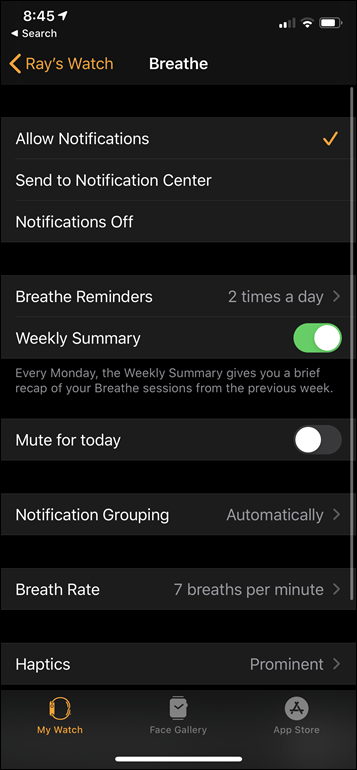
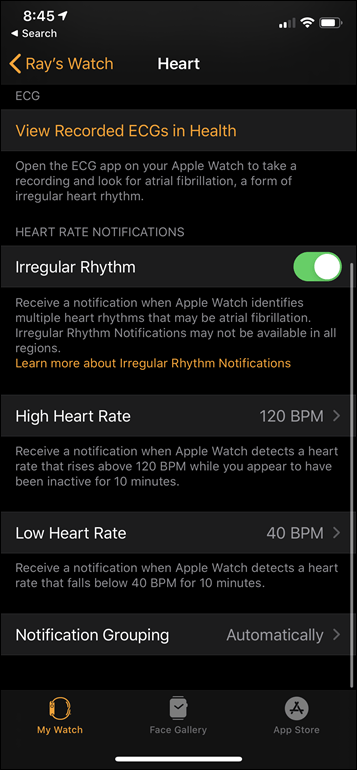
And assuming you’re in a country that permits it, you’ll have access to Apple’s ECG functionality, which they launched last year in the US and this year in Europe and a few other locales. To enable that you’ll open the ECG app on your watch and then hold the digital crown with the other hand.
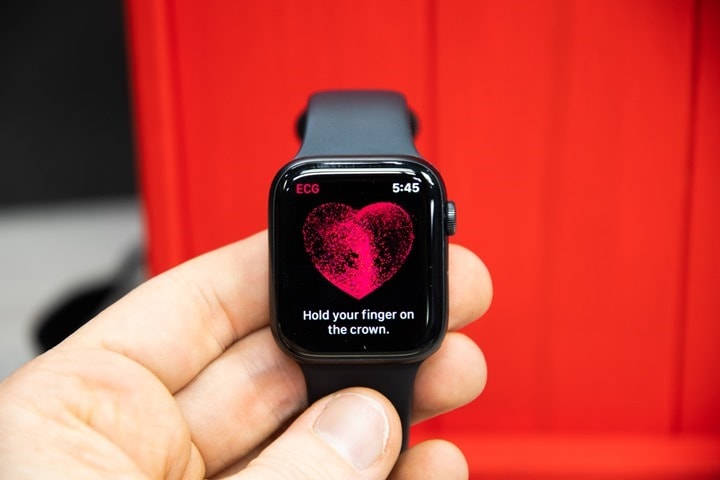
During that 30 seconds it’ll perform the ECG, all while showing you a pleasing animation.

At the end of it, it’ll spit out your results, and also file a more detailed report on your phone that you can send to a doctor in PDF form.
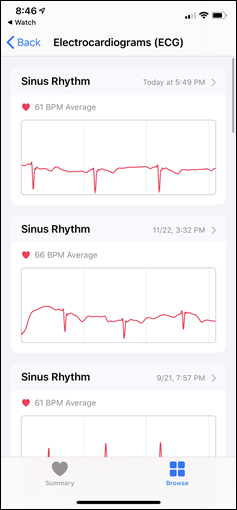
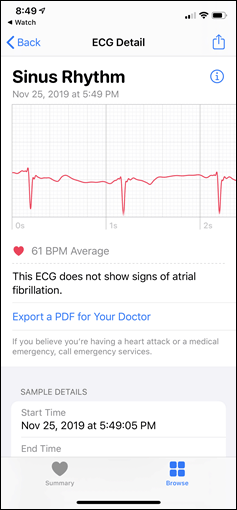
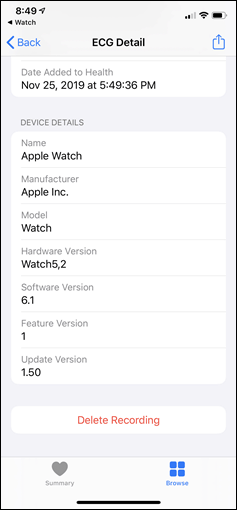
It’s smooth and functional. For most people though, it’s a feature you’ll use once and likely never again (until you find it on a random evening sitting bored on a couch and then do it again). Which doesn’t mean it’s not valuable – it absolutely is, and absolutely is making a difference. However, I’d be hesitant to buy the watch just for that specific feature unless you have a health condition that said feature would be used regularly. Still, I like to see companies push the boundaries. And especially Apple, due to their scale here.
With all the basics out of the way – let’s dive deeper on sports.
Sports Usage:
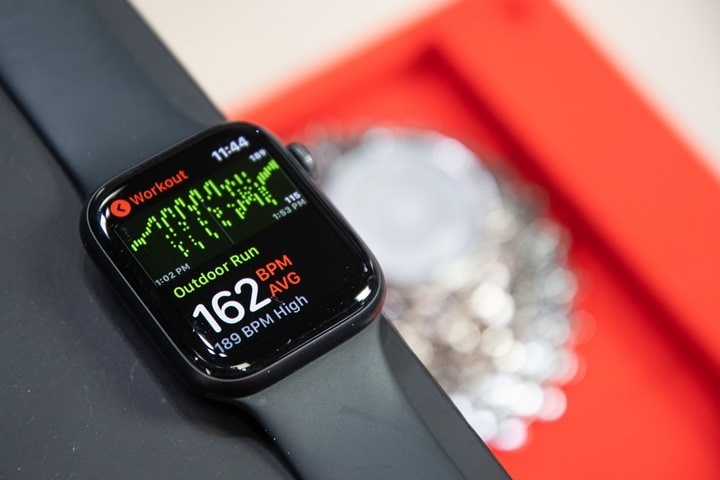
For this section I’m going to focus primarily on the built-in apps. I know there are lots of great apps out there that do great things with workouts. For example the ability to get coached workouts, highly structured workouts, more sensor support, course routing, and plenty more. And I talk about some of those later in this post. But, for the vast majority of people, they’re going to use the default apps for capturing workouts.
Still, let’s start with the basics first – and that’s getting the workout app opened. The workout app is the yellowish-green one below:
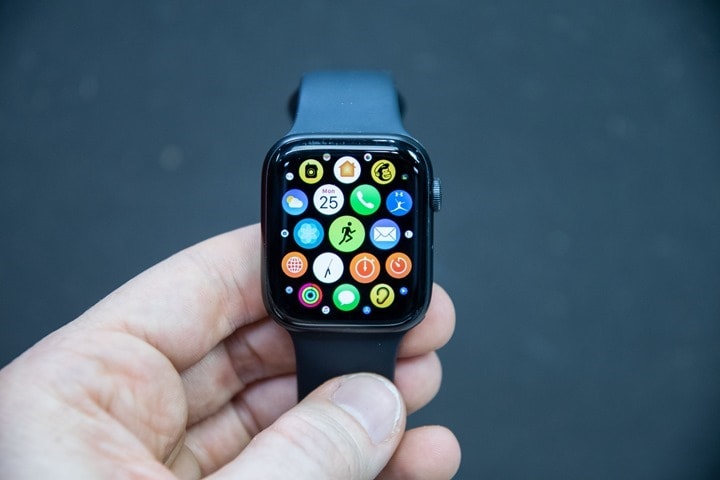
After which you’ll see a list of sports you can choose from. If you tap on the three dots in the circle, it’ll allow you to customize the goal of the workout. By default when it says ‘Open Goal’, it means you’ll do the sport for as long as you want, or until you collapse it.
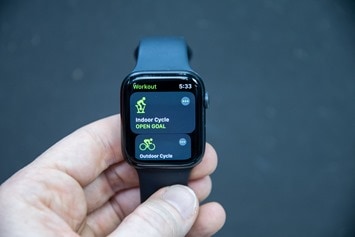
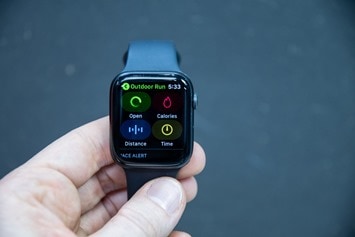
In addition, it’s here that for certain sports (like running), you can set a pace alert. You can even apply it to the rolling or average pace as well, if you want to.
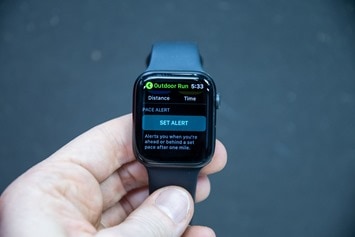
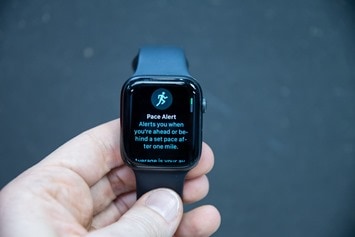
The initial list of sports are as follows (the same as from the Series 4): Outdoor Walk, Outdoor Run, Outdoor Cycle, Indoor Walk, Indoor Run, Indoor Cycle, Elliptical, Rower, Stair Stepper, High Intensity Interval Training, Hiking, Yoga, Pool Swim, Open Water Swim, and Other.
However, you can then go down further on the app and choose ‘Add’, which brings up another massive list of additional sports.
You can customize various settings via the Watch app on your phone. These include Running Auto Pause, Power Save Mode (turns off optical HR), Start/End of Workout Reminders, as well as workout playlists. I personally leave the power save mode and running pause off, since I want all the data!
Also, if your gym has gear that’s compatible with Apple’s GymKit functionality, then you can utilize that as well. No such gym that I belong to has that though unfortunately.
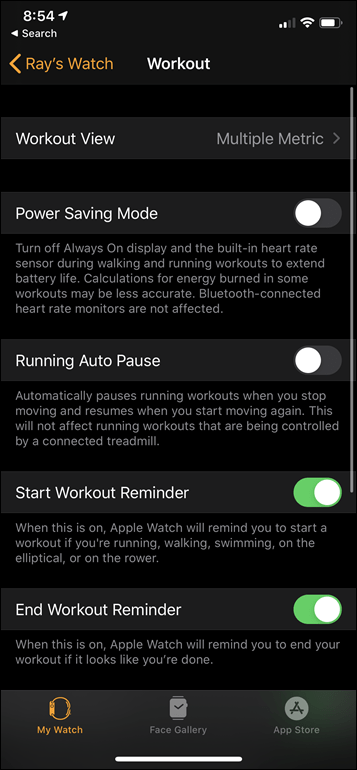
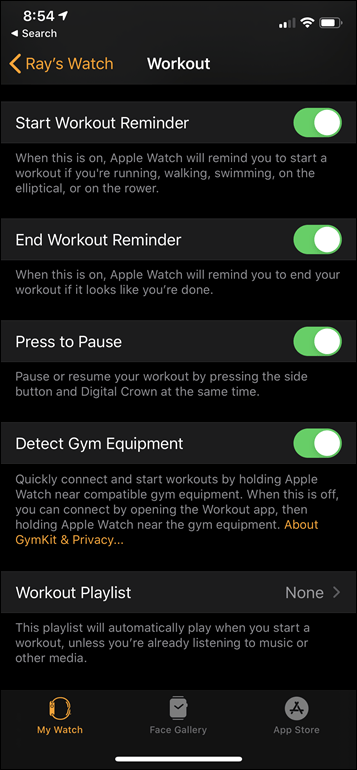
For each of the workout types, you can select the data fields you want displayed, as well as whether you want multiple metrics on a single screen or have them on a single page individually. Both are within the ‘Workout view’ option. You can select up to 5 custom metrics to be included:
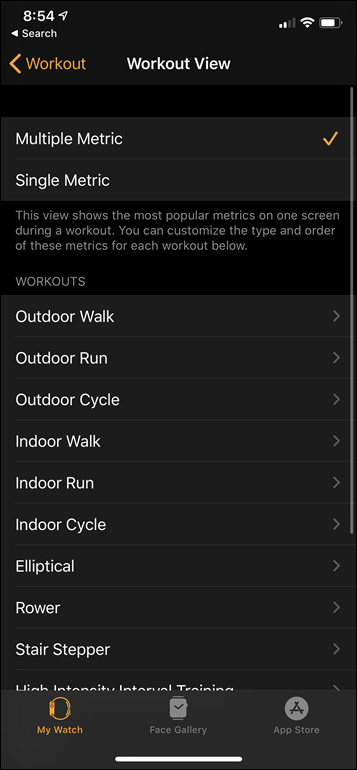
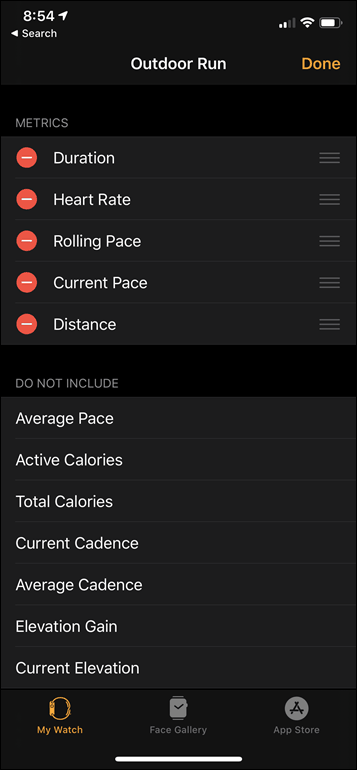
Rolling pace is one of my favorites for longer runs (but not intervals), as it allows you to see the rolling pace over the last mile (or kilometer). That’s different than something like a lap-average, because if you just start a new lap that resets the average and might not give you a good indicator of how well you’re pacing over a longer time period (like a mile).
In any case, with everything sorted, head back to the watch and press the sport name again and it’ll start a three-second count-down:
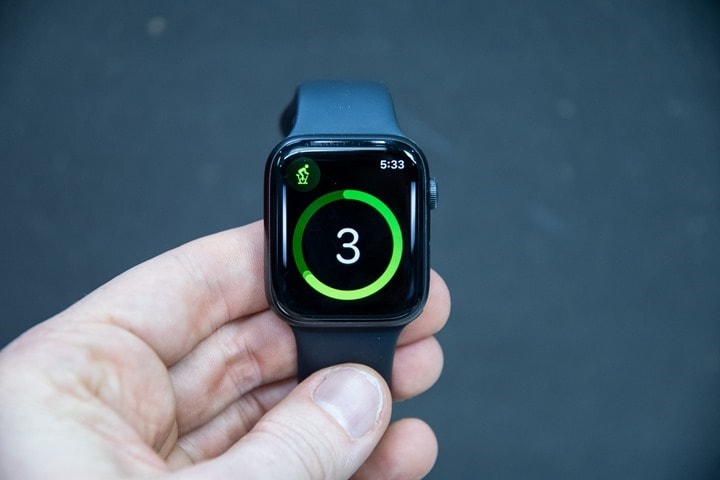
Now just like last year, it’s during these three seconds that the most ‘controversial’ element of the Apple Watch comes to light. And by ‘controversial’ I mean that most tech reviewers skip right over it, but it’s what fundamentally separates the Apple Watch from all other fitness wearables today. And unfortunately, not in a good way.
See, normally when you have a fitness GPS watch and go to the sport modes two distinct things happen:
1) GPS acquisition begins: It goes out and finds satellites. In most cases this only takes a few seconds with newer watches. But it could take longer in tough locations like NYC. If your phone is nearby, however, Apple uses the phone’s GPS instead. I will repeat: The Apple Watch will *always* use your phone’s GPS instead of its GPS unless the phone isn’t accessible.
2) Optical Heart Rate acquisition begins: While Apple is constantly monitoring your HR in a 24×7 mode, it’s actually doing so with a different set of lower power sensors to save battery life. When you go into workout mode it switches things up and needs to reacquire the heart rate with sensors and algorithms more attuned to hard workout activities (this is actually normal for many wearables). Sometimes this will happen in a few seconds, other times it’ll take 1-2 minutes.
Both of those tasks take time. But Apple doesn’t think time is sexy, so it just counts to three like a toddler and hopes for the best. After which off you go thinking that everything is ready. But in reality it almost never is. So you get gaps of data instead. You’ll notice your heart rate isn’t displayed initially (last line):
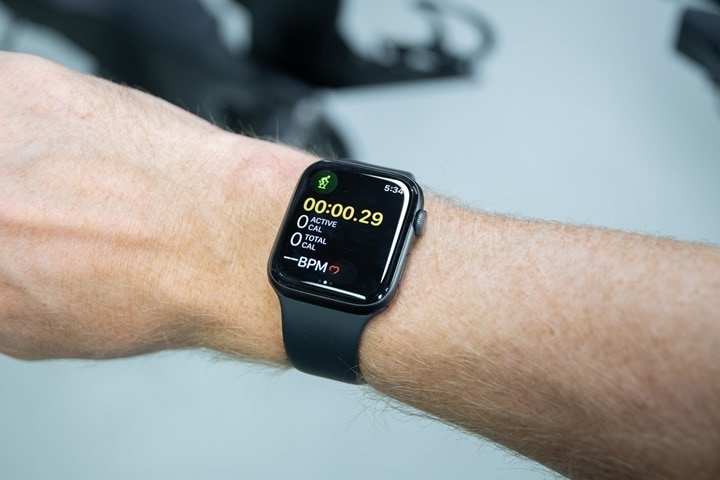
In fact, if you look at charts for the heart rate over the first 90 seconds, it’s often missing entirely, or they’ll substitute a fake value until they get HR lock. This tends to be exaggerated in running, whereas something like an indoor spin bike or trainer, tends to lock faster (due to less movement).
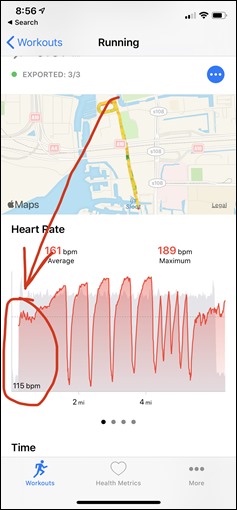
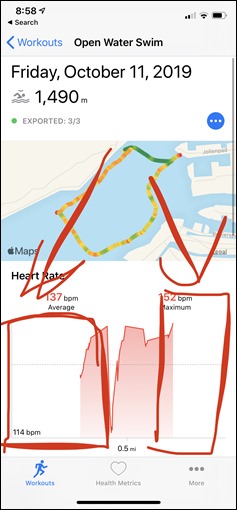
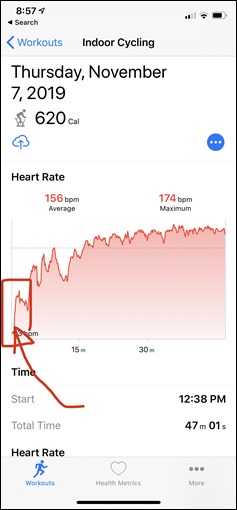
What’s funny about this (and this was the same the last two years) is that the act of not waiting actually increases the inaccuracy. It makes it harder for heart rate to acquire, and harder for GPS to acquire. In reality, if Apple were to just show GPS/HR status icons like every other watch – then you might wait a few more seconds but your data would be present and accurate.
Still, that’s not sexy and polished like the Apple mantra. And you think this focus on sexiness ends here? Nope, Apple actually fictionally smooths your corners in GPS tracks to make them look sweeping and majestical. But only in their own app. Check out these side by side GPS tracks between the Apple Watch and a Garmin and Suunto watch. Note where I enter/exit the looped track, the Apple Watch makes sweeping curves (I didn’t run that way). If you look at the satellite imagery, you can see quite clearly that’s not where the path goes. It just swoops around it.
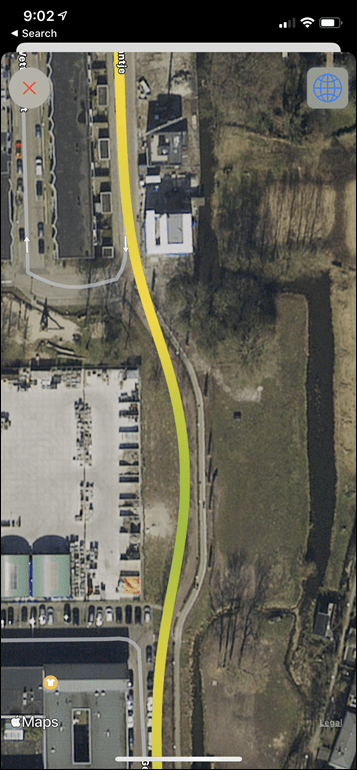
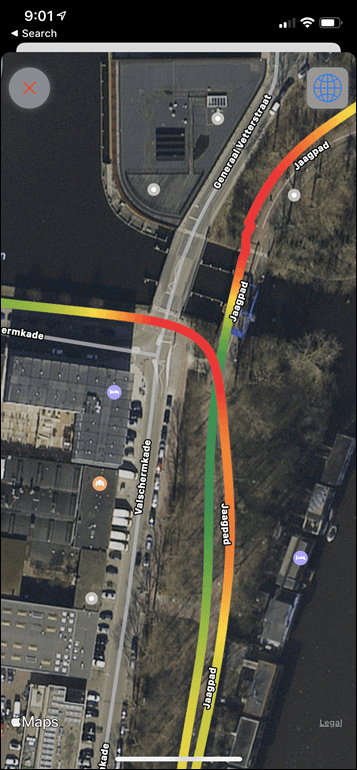
Now to Apple’s credit, this has gotten slightly better over the last year – we saw some changes earlier this year that helped a bit. But the above are screenshots from the last couple weeks on the most current firmware. Apple’s clearly trying to find balance here between the occasional mess that is GPS precision, and just showing you something that is cleaner. For example, you can see at this juncture it does make a nice sharp turn (even though it still gets the path wrong on the example to the right). It seems like Apple has worked to improve these sorts of sharper turns, but still lets the more ‘flowy’ GPS track offsets occur.


I do actually think they’re getting closer to that happy-state, but it’s not quite there yet.
In any case, we’ll talk more about accuracy in a moment (both heart rate and GPS). In the meantime, back to our run. As you remember we were just starting it before I got sidetracked. Once running (or riding or whatever) you’ll see your stats displayed.
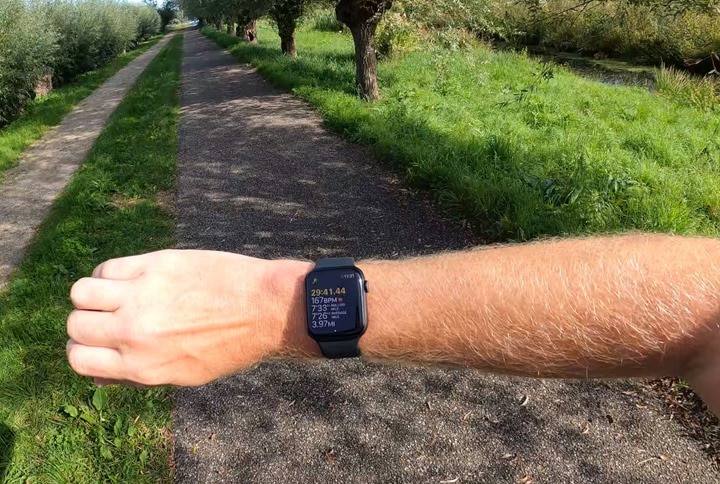
With the default app you don’t really get a ton of stats. If you want more stats you’ll want to look at 3rd party apps like iSmoothRun for example. However, there’s a catch with that: None of those 3rd party stats can utilize the ‘Always-On’ display. So while during a workout with the native Apple Watch app you’ll be able to see all the data metrics, even when your wrist isn’t raised – that same isn’t true for 3rd party apps.
For example, let’s say you use the Strava app. This is what happens when it doesn’t detect your wrist being raised – it’s just fuzzy:
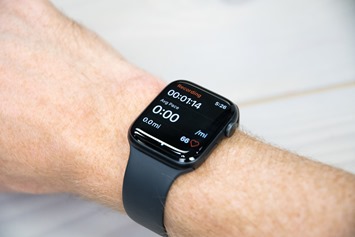
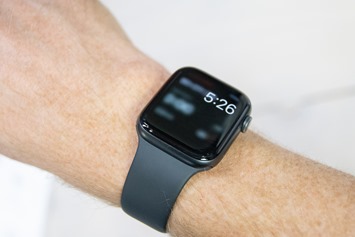
And the same is true of *every* 3rd party app, because Apple doesn’t support always-on mode for 3rd party apps. Here’s a workout app I used to collect power meter data showing the same view:
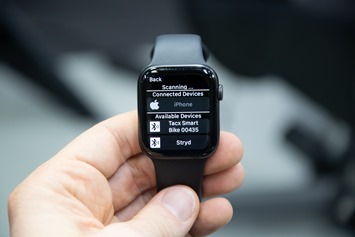
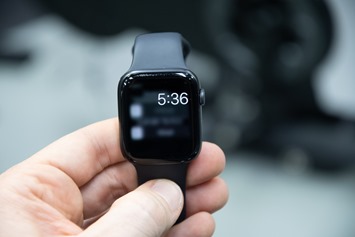
Back on Apple’s app, if you’ve enabled features like auto-lap, it’ll trigger notifications every kilometer or mile (I have mine set for every mile). Note that the Apple Watch can connect to 3rd party Bluetooth Smart heart rate straps, in the event you don’t trust the optical HR sensor. It cannot connect to ANT+ straps though. Of course, many straps these days are dual ANT+/Bluetooth Smart, so it’s really not an issue.
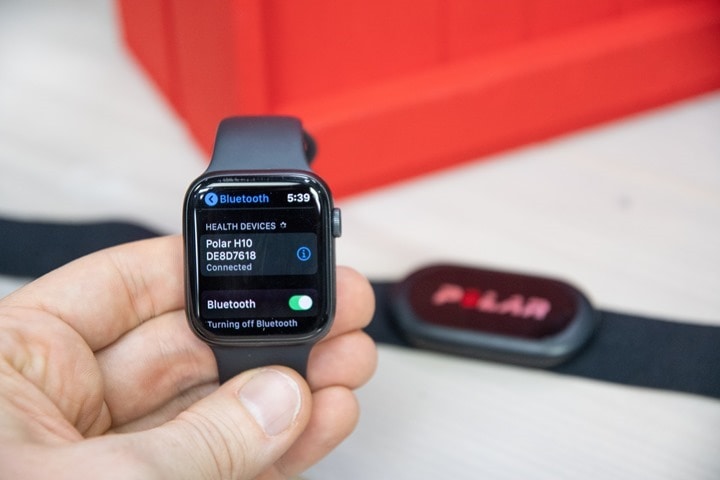
For sports like pool swimming, it’ll ask you to confirm the pool-size. Pool swimming won’t use GPS of course, but rather the accelerometer internally, so it needs to know the length of the pool to be able to determine the total distance. And for all swimming, including openwater swimming, it’ll let you know that the touchscreen will be locked until you rotate the digital crown.
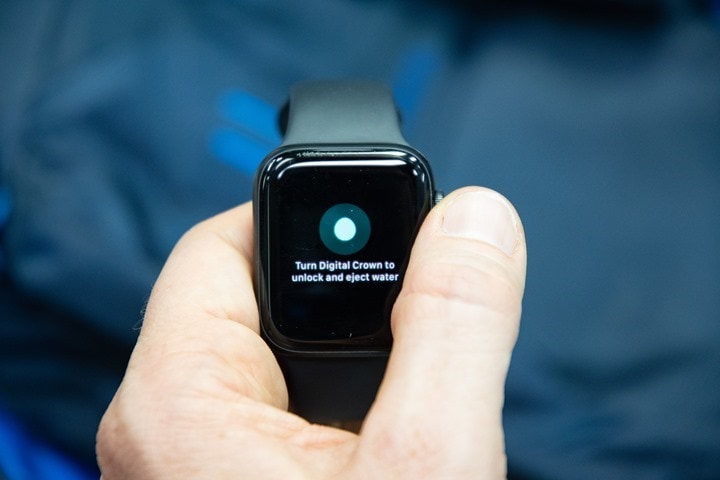
I’ve used it in both pool and openwater swimming. I’ll cover the openwater bits a bit down below.
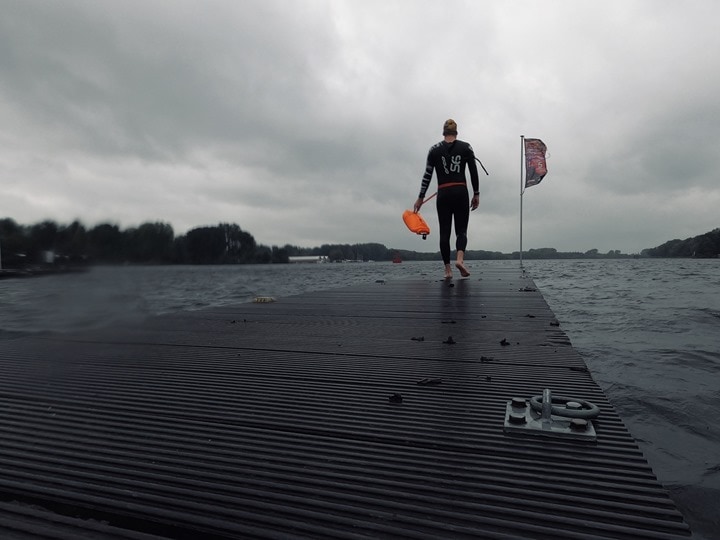
No matter the type, once you’ve completed the workout you’ll get a summary page that you can look at. And you can dive more deeply into certain areas like heart rate stats as well from the watch.
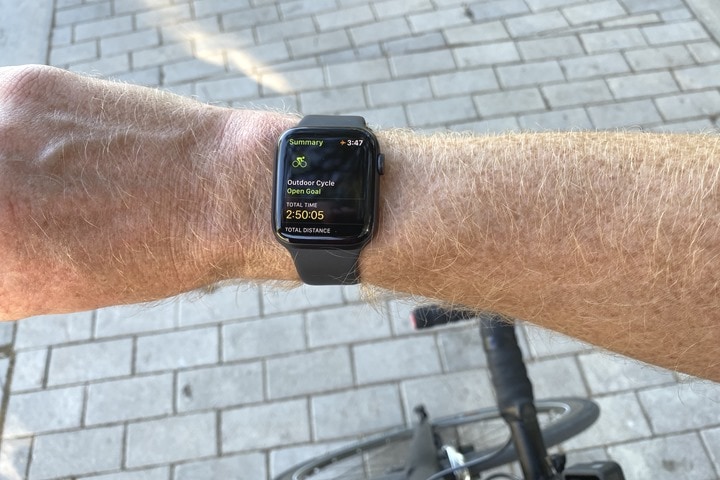
Additionally, if you switch back to the phone app you can get more stats, including splits and a map of your route:

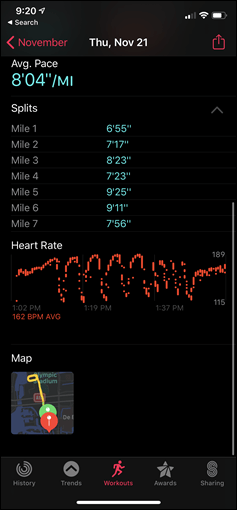
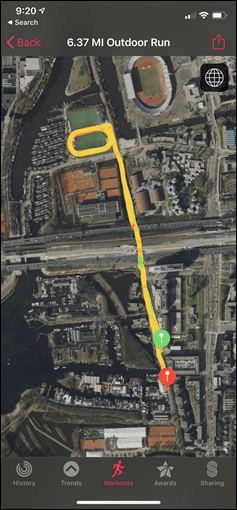
As I’ve noted in the past – most of this information is fairly basic in comparison to what other companies provide in the space, especially sport-specific companies like Garmin, Suunto, and Polar. You won’t find things like advanced recovery metrics, or training load. None of that makes it into the default Apple Watch experience. Some 3rd party apps have more details, but again, not Apple themselves.
And that’s probably just fine. Most people don’t care about those metrics, and thus it doesn’t really fit into the Apple-like realm of ultimate simplification for the widest possible audiences. Apple will sell tens of millions of these watches this year, and only a small fraction of those people will actually use the workout modes regularly.
Still, I’m surprised that we’ve yet to see Apple add any basic interval or structured workout support. After all, Fitbit has seen good success there. And even more so as companies (including Fitbit and others) have looked to add basic coaching type capabilities to mainstream wearables. Apple would likely contend that’s why they have such a vibrant app store with so many options. And again, I’m also not sure they’re wrong here either – but in my opinion they just leave the door open.
In comparison, Garmin’s millions of units per year are small – but they’re also potential revenue for Apple. A slight nod to workout routines would be at least some new feature for the WatchOS crowd, which aside from a couple of very minor new tweaks, hasn’t actually seen much in the way of sport/fitness newness in a few years now.
Data and Apps:
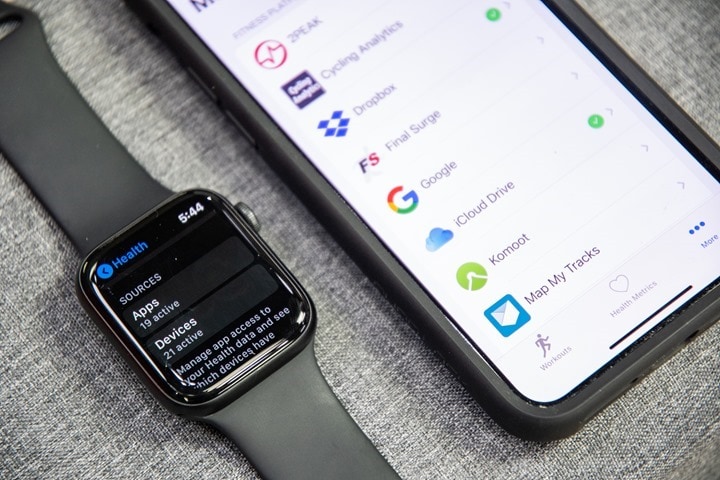
One of the things that makes the Apple Watch so appealing is the app ecosystem. The vast majority of apps you’ll use day to day seem to have some sort of Apple Watch companion app with it. Some are very basic offering no practical added value, while some are extensive and eclipse the phone app itself in value. And with WatchOS6, we’ve seen Apple now allow apps to be installed directly from the watch itself. I suspect that’s a move to eventually enable Android connectivity in future iterations – a theme that would be highly consistent with Apple’s branching out beyond the walled garden of Apple (see: Apple Music, Apple TV+, etc…).
However, despite that, there’s still challenges to that wall. Inside those walls is a vibrant garden. And in fact, the data and organization is astonishingly accessible to you as a consumer. Well, mostly. At least until you try and take that kiwi out of the garden, then it requires a maze of hoops. But we’ll get to that in just a moment.
All of the fitness/sport/health data goes into the massive repository that is Apple Health, which is accessible to apps (with your approval) via HealthKit. Note that this is kept entirely on your device. There is no cloud service or online platform for Apple Health data – a key differentiator (good and bad) from other companies’ platforms (though, you can backup/restore it via iCloud as part of your normal iPhone recovery process).
For most data, you can view it directly in Apple Health, via the ‘Health’ App on your phone. Some of this data, like steps and stand hours, have nifty graphs:

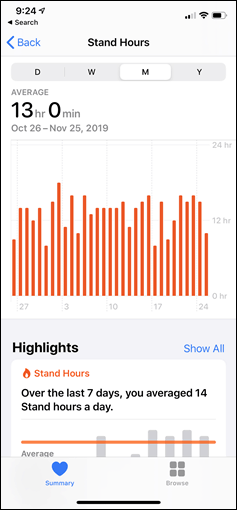
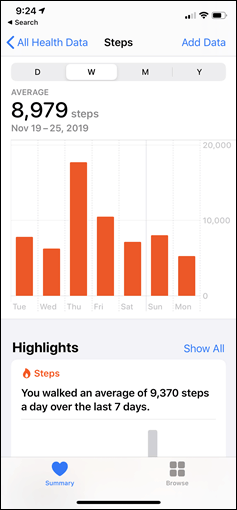
But lots of the data is a bit more nuanced in nature and dumped into huge database tables, though, you can still view those too:

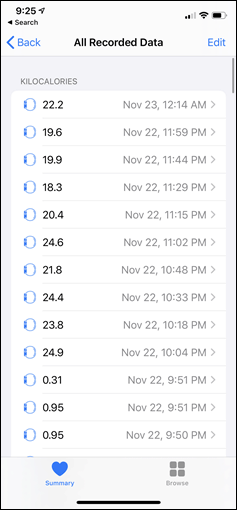
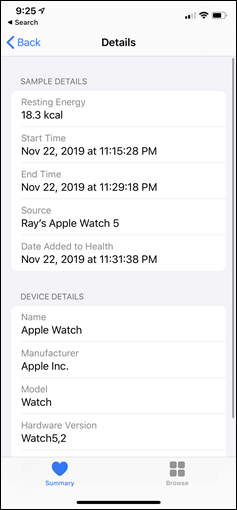
In fact, you can see how each device I use contributes data. For example within this walled garden, Apple & Garmin actually play surprisingly well to contribute data to my day. Garmin for example can send in sleep data, while the Apple Watch adds in ECG data. Two sources can also blend their data too. While from an industry fitness standpoint it can be frustrating (as it utilizes zero standards for how to transport fitness/sport data), the actual data there is incredibly powerful.
But….what if you want to get it out? What if you want to get that workout you just did on your Apple Watch using the native ‘Workouts’ app and send it to Strava? Or TrainingPeaks? Or Dropbox?
There’s a few apps for that – but the one I keep going back to is HealthFit. It supports sending to boatloads of data partners, and does so in a way that conforms to standards, namely the .FIT file.

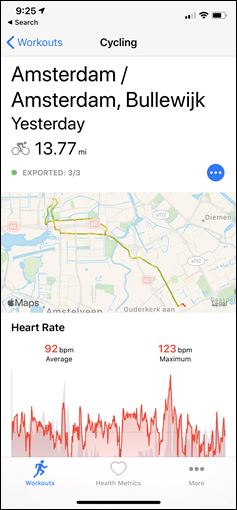
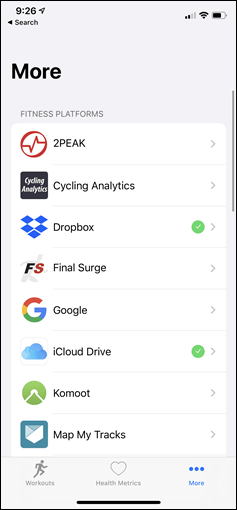
You’ll see your workouts enumerated from the Apple Health database, and you just select which ones you want, and off it goes uploading them. Up until this fall it used to do that quietly in the background, but Apple changed some permissions model that restricts how frequently apps can tap into HealthKit in the background, so now you’ve mostly got to do it manually. Though it’s no big deal.
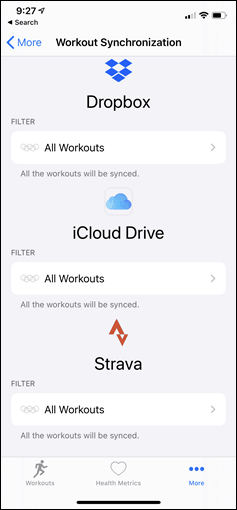
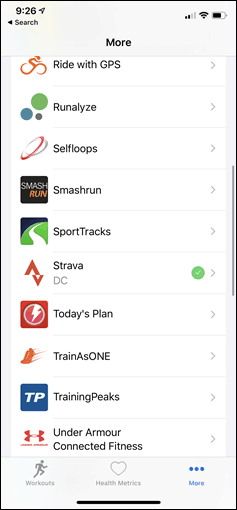
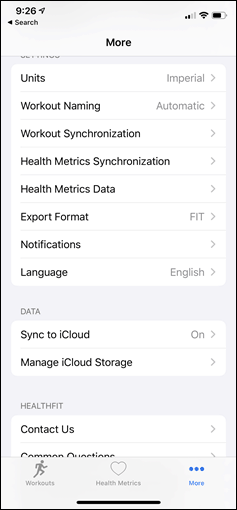
I use this app for all of my Apple Watch data needs. For example, all of the data in this review pipes through that app (as there’s zero other ways to get it). And even my ride yesterday using the Apple Watch I did with the native app, and then used this app to upload it to Strava. It’s 100% worth the $3 that it costs to get the data where you want it.
(Note: I don’t have any paid/sponsored/whatever affiliation with any of the above/below apps. I paid my own two bucks or what-not for all of them…and plenty more.)
The next app that I used was to record cycling power meter data. Up until now, this has mostly been impossible to do on the Apple Watch itself, without having your phone nearby as a conduit. Meaning, there were apps that allowed you to display cycling power meter data on the watch, but they all required your phone be there to make that connection. However, the Train2Peak app now has that capability entirely within the Apple Watch app (and isn’t limited to just Series 5). Here you can see me pairing it to my Garmin Vector 3 power meter:
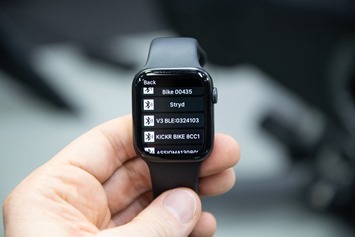
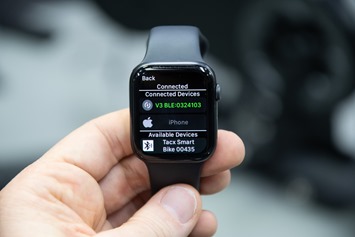
And then here I am mid-ride:

The interface to start a ride can be a little bit slow/cumbersome, but that’s honestly largely a limitation of the Apple Watch platform/user interface by the looks of it. And once the ride is started, off it goes recording it perfectly fine. The data has exactly matched while I was riding compared to my Garmin (over Bluetooth Smart). Afterwards the data syncs both to their cloud platform, as well as into the Apple Health database, and you can also export it via e-mail or to Strava.
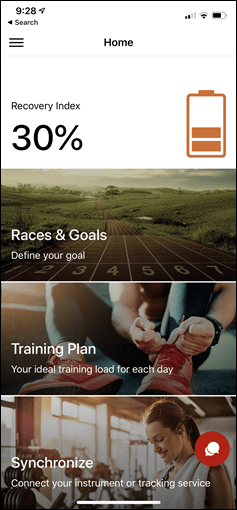
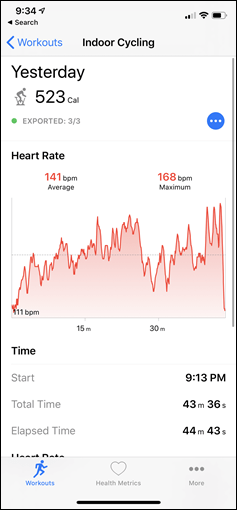
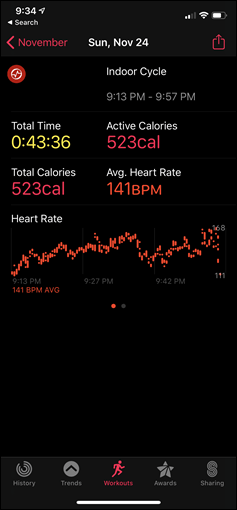
Finally, there are a few apps I’ve used successfully in the past, though didn’t use this time around. The reason I didn’t use them doesn’t mean there’s anything wrong with them, they’re still great and well-maintained apps.
WorkOutDoors: This is mapping/navigation focused and allows you to download a map segment to your Apple Watch for navigation. You can import in tracks/routes and then follow those tracks against the map on your watch. Basically, it’s like having a mini version of a Garmin Fenix series watch. Cool stuff.
AutoSleep: So this app allows you to get sleep data on your Apple Watch. Unlike many apps – this requires zero end-user interaction. Some apps require you to ‘start’ and ‘stop’ your sleep, which I find silly and 1980’s like. This just does it all in the background magically and then you use the iPhone app to view the data. Sweet!
RunGap: This app is somewhat like HealthFit above. It allows you to upload/export to various services as well. I haven’t used this one as much merely since I’ve mostly just used HealthFit. I’m kinda a ‘if it works don’t try and fix it’ kinda guy. Though I know plenty of people use RunGap, here’s a bit of a review from last year – but one from a source I trust that walks through the functions.
Finally, one general caveat when looking at Apple Watch apps is to ensure the app is able to function in a standalone non-phone connected manner. Some apps have features that only work when in connection with a phone nearby (such as connecting to certain sensors), while other apps can be fully freestyle and go tetherless. A great example of that is the Spotify app. Yes, Spotify can indeed be installed on the Apple Watch. Except one itty-bitty caveat: You can’t download music to it. It’s just for controlling your other devices.
One quick and easy way to test whether something depends on your phone is to turn off Bluetooth on your phone (via the Bluetooth control panel, else it’s not really off). Or, just stick your phone in your microwave (don’t press start!!!) – which creates a signal-jamming bubble around it.
GPS Accuracy:
There’s likely no topic that stirs as much discussion and passion as GPS accuracy. A watch could fall apart and give you dire electrical shocks while doing so, but if it shows you on the wrong side of the road? Oh hell no, bring on the fury of the internet!
GPS accuracy can be looked at in a number of different ways, but I prefer to look at it using a number of devices in real-world scenarios across a vast number of activities. I use 2-6 other devices at once, trying to get a clear picture of how a given set of devices handles conditions on a certain day. Conditions include everything from tree/building cover to weather.
Over the years, I’ve continued to tweak my GPS testing methodology. For example, I try to not place two units next to each other on my wrists, as that can impact signal. If I do so, I’ll put a thin fabric spacer of about 1”/3cm between them (I didn’t do that on any of my Apple Watch Series 5 activities however, all workouts only had a single device per wrist). But often I’ll simply carry other units by the straps, or attach them to the shoulder straps of my hydration backpack. Plus, wearing multiple watches on the same wrist is well known to impact optical HR accuracy.
Next, as noted, I use just my daily training routes. Using a single route over and over again isn’t really indicative of real-world conditions, it’s just indicative of one trail. The workouts you see here are just my normal daily workouts.
I’ve had quite a bit of variety of terrain within the time period of Apple Watch testing. This has included runs in: Amsterdam (Netherlands), French and Swiss Alps, and Mallorca (Spain). Cities and mountains, trees and open-air, plus waterways and seas. It’s hit them all.
First up we’ll start with something relatively easy, a run south from Amsterdam. On this initial test I’ve got a mere five GPS devices, three of which are attached to a running stroller, and the remaining two (including the Apple Watch Series 5 and Garmin Venu) are on my wrist. Here’s that data set:

At a high level, things look mostly fine. But let’s dig into the weeds. No, really, the actual weeds. To the right of these tracks is a pasture where horses hang out. In the below case, the Garmin FR945 is almost perfectly atop the running path. You’ll see the Garmin Venu is off to the right, while the Apple Watch is off to the left. The Garmin Venu is slightly more offset than Apple, but Apple cuts more corners.

If we got a bit further in the run, you can see this play out again. That white line is the actual path I ran on (and if I toggle to satellite view, it matches there, it just makes this picture harder to see due to the trees). You see that the Venu is super close here, whereas the Apple Watch cuts the corners nonchalantly. Which isn’t as bad as the COROS Vertix and FR945 being offset entirely (way into the woods).
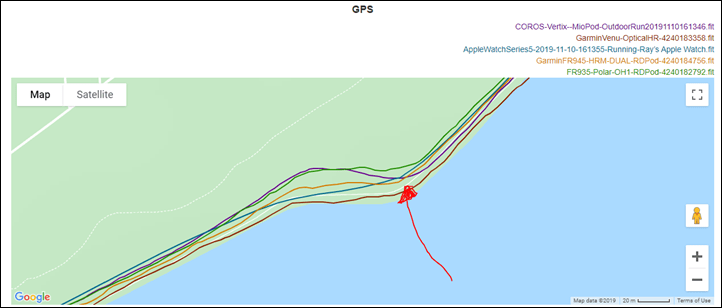
See, one exhibits a track offset (whereby it mirrors the turns, but doesn’t match where you went), while the other simply cuts corners. You see it again here on this next corner:

And again this mess of a loop here. Apple cuts the corners, and Garmin is off in the drunk. Equally bad, just bad in different ways.
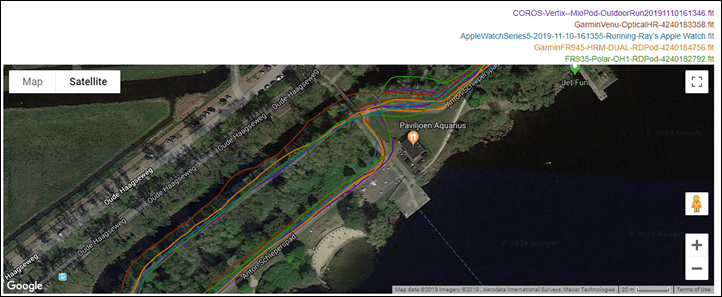
Now…this is nitpicking. No doubt about it. And at first glimpse it might not seem so bad. But then you look at the total distance and realize it all adds up. Every Apple overshoot adds up eventually (despite the cut corners). It’s nearly 300m longer after 10KM than the others.

I normally hate showing total distances, because you can be wrong 100% of the time and still get distance right (via enough corners/overages). But generally once we get this many units at once, there’s definitely something to patterns.
Next, let’s look at something a bit simpler: A track workout.
Technically it’s both a track workout and testing the ability of this watch to draw a straight line. The path I ran down is precisely straight. Crazy straight in fact. I take it every single day to and from work. It’s great…and goes under a gigantic ring highway that loops around the city – perfect for testing GPS re-acquisition. Here’s the high-level overview, and data set from just a few days ago.
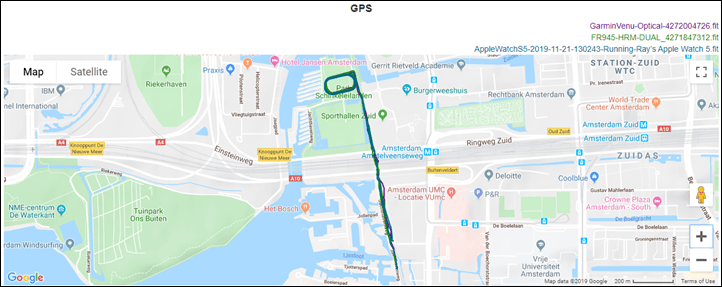
Let’s zoom in first to that massive bridge set. This includes two railroad bridges along one of the busiest rail corridors in Europe. Plus two highway overpasses. It’s hundreds of meters wide. And, for the most part all three units handled it just fine. The Venu did stumble very slightly coming back out one direction, but not significantly.

As for the straight section? Hmm…not so hot. At least not initially. From the outside they were a bit rough, but as they returned an hour later, they were much closer. This path is technically tree-lined on both sides, so that probably wasn’t helping matters.

So the big moment – the track itself? For this I stayed exactly in Lane 1 (there was nobody else there), and round and round I went. About 10KM of round and round worth. I want to point out three things. Actually, four things, but with three arrows.
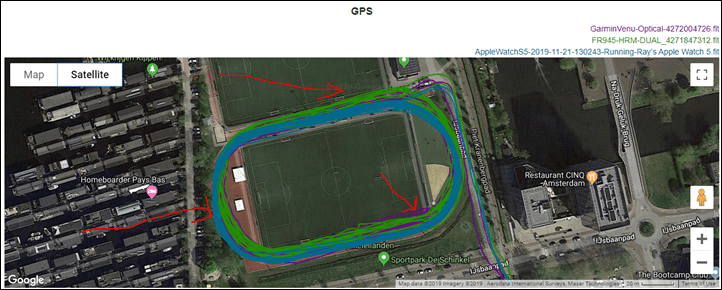
First off, before I do that – note that no matter how good your GPS is, in 2019, I still recommend doing track workouts by just counting distance. At least for the specific sets. Meaning, you should be looking at the markings on the track to know when you’ve run 400 meters, 800m, and so on. I merely use my watch for historical data purposes on a track, as well as managing heart rate and time. I don’t generally use it for pacing via GPS (or footpod). I just do mental math.
That said, these three arrows show us four things:
1) All units were pretty darn close. Nobody was off out of the property or anything weird.
2) The Apple Watch was slightly offset to the left, you see that left-most arrow in the woods point at the Apple track.
3) The Garmin Venu took a few brief dips into the lower right infield of the pitch
4) The FR945 seemed to favor being slightly on the upper outer edge, meaning it was slightly offset a touch bit north
All in though, these results from a GPS track (as in, the line itself) are perfectly acceptable to me for historical record keeping.
Next, let’s look at another set. This time swapping out in the open water for a swim. Previously I’d have said that the Apple Watch Series 4 was the reigning king for openwater swim GPS accuracy. But, as you can see – that’s no longer the case. Here’s the data set:

Note: For openwater swims I have one watch per wrist, but then I also have a reference watch atop a swim buoy that floats just behind me a few inches.
Now, the Apple Watch didn’t make any major mistakes, and overall it’s very good. But you can see as I started off on the first crossing of the channel, it wasn’t spot-on:

It’s hard to see in teal, but it basically cuts across in the wrong spot, and then does a weird loop-de-loop on the other side. Whereas, the Garmin Swim 2 and FR945 reference track are near identical.
If we go down a ways till when I cross back over again, you’ll see a small quirk. I had to wait here a few seconds for a ship to pass through. It looks like I drifted very slightly, which both the reference track and Apple Watch Series 5 picked up. We’re only talking a few meters extra, but the Garmin Swim 2 appeared to smooth that out.

Meanwhile, on the other side of the lake when I made my next turn you see the Apple Watch cut the corner a little bit again, whereas the Swim 2 handled it nicely.

On the last buoy, I went to the left of it. Here it shows me going through it on the Garmin Swim 2, and to the right of it on the others. Of course, it’s totally possible the buoy has moved slightly. Either way, it’s pretty close for both units.

There’s some more openwater swim sets with the Apple Watch Series 5 in my Garmin Swim 2 In-Depth Review, if you want to dig in there (as well as indoor swims).
In addition, I have dug through my GPS tracks from outdoor bike rides as well (including some mountain areas), and found it pretty much fine. For example, here’s this ride in Mallorca (Spanish island) through very rocky/mountainous terrain. Here’s that file.
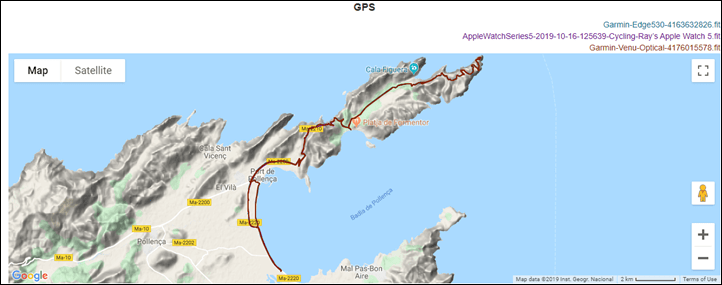
Though, there was one particular spot that the Apple Watch did struggle, which is seen below.

However, it actually wouldn’t have been the Apple Watch, but rather my iPhone 11 Pro. Remember: When the Apple Watch is within range of your iPhone, it will always leverage the GPS signal from the iPhone. This, as you can see above with that errant line, is one reason I tend to take cycling Apple Watch GPS tracks with a grain of salt. I’m almost always cycling with my phone – so it’s kinda pointless to dissect the Apple Watch tracks there.
Ultimately – what I see on the Apple Watch Series 5 is pretty darn similar to what I saw on the Series 4. It’s good, and the tweaks to WatchOS/firmware over the last year have made it better than before – but it’s still not great. I’d say Apple’s openwater algorithms are better than their land algorithms. But at the same time, for 99% of people, it’s more than acceptable.
Apple essentially trades precision for smoothness. Part of the swooping I make fun of is ultimately just Apple cleaning up GPS tracks so that the average person looking at them doesn’t pick them apart with all sorts of typical GPS noise. On the flip-side, it means corners often get cut. Apple banks on the fact that people don’t look terribly closely at GPS tracks to see the cut corners, but would instead notice more sharp GPS errors. Realistically, they’re probably right from a marketing standpoint, even if they’re wrong from a technical standpoint.
(Note: All of the charts in these accuracy sections were created using the DCR Analyzer tool. It allows you to compare power meters/trainers, heart rate, cadence, speed/pace, GPS tracks and plenty more. You can use it as well for your own gadget comparisons, more details here.)
Heart Rate Accuracy:
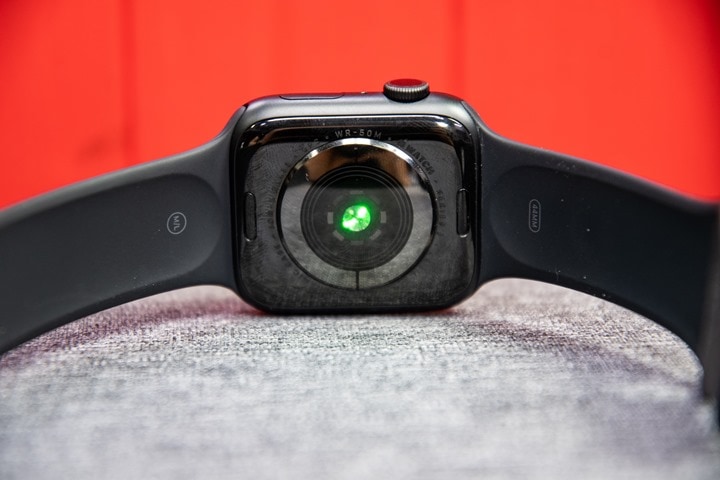
Next up we’ve got heart rate accuracy. This roughly falls into two buckets: 24×7 HR, and workout HR. As is usually the case with most devices these days, I see no tangible issues with 24×7 HR. It works well across both normal daily routines as well as things like sleep. Speaking of which, I talk about RHR values and 24×7 monitoring here and why it’s interesting.
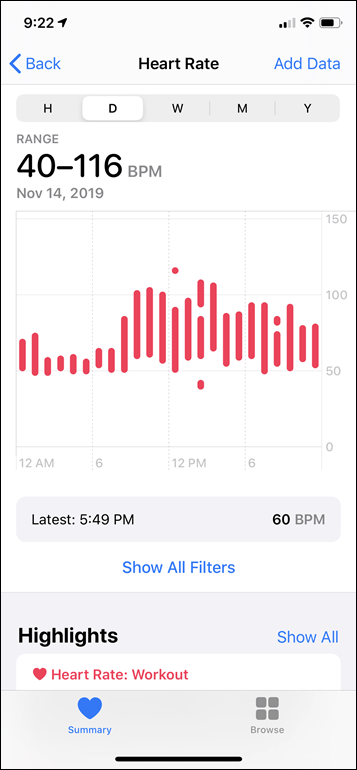

Before we move on to the test results, note that optical HR sensor accuracy is rather varied from individual to individual. Aspects such as skin color, hair density, and position can impact accuracy. Position, and how the band is worn, are *the most important* pieces. A unit with an optical HR sensor should be snug. It doesn’t need to leave marks, but you shouldn’t be able to slide a finger under the band (at least during workouts). You can wear it a tiny bit looser the rest of the day.
Ok, so in my testing, I simply use the watch throughout my normal workouts. Those workouts include a wide variety of intensities and conditions, making them great for accuracy testing. I’ve got steady runs, interval workouts on both bike and running, as well as openwater swimming – though, I didn’t focus on optical HR accuracy there.
For each test, I’m wearing additional devices, usually 3-4 in total, which capture data from other sensors. Typically I’d wear a chest strap (usually the Garmin HRM-DUAL or Wahoo TICKR X) as well as another optical HR sensor watch on the other wrist (lately the Polar OH1 Plus, as well as the new Mio Pod lately). Note that the numbers you see in the upper right corner are *not* the averages, but rather just the exact point my mouse is sitting over. Note all this data is analyzed using the DCR Analyzer, details here.
Oh – and note that I’m going to focus almost exclusively on very recent data here – meaning, all on the latest firmware update (WatchOS 6.1). Whereas my earlier impressions were on WatchOS 6. Though, I don’t think it has anything to do with WatchOS per se, but quiet and underlying changes made for Apple Watch Series 5 itself (since it wasn’t seen on Apple Watch Series 4 on WatchOS 6).
In any case, first up is a nice run south out of Amsterdam. Nothing too tricky here to begin with – relatively stable, except also pushing a stroller (which can be challenging for optical HR). Here’s data against the Garmin Venu (optical HR sensor on other wrist), the Garmin HRM-DUAL chest strap, and the Mio Pod strap on my upper arm (data set here):

The Apple Watch is the teal one. Though of course, you can’t really see that – because they’re all virtually identical.
The only difference is the chest strap struggles the first few minutes to gain lock. I had got the strap wet, but it looks like by time I got everything ready to go with 6+ devices, it dried out again. Welcome to cooler/dryer fall running days. When people talk about how optical HR sensors are always less accurate than chest straps – I simply point to cases just like this. It’s not as cut and dry as people like to make it seem.
Years ago before optical HR sensors became common, the most popular post every fall was how to troubleshoot chest HR strap issues. What’s old is new again.
In any case, the only other time we see any variance here is briefly from the Garmin Venu where it stumbles a bit within a 60-second span. This could be due to the pressures from pushing the stroller, or could be anything else. Either way, all three are very similar.

So…let’s kick it up a notch.
Interval time!
Here’s a track workout I did last Thursday, a bunch of 800’s and then a bunch of 200’s. Plus a warm-up and cool-down. Here’s that data set:

Let’s zoom right into those first few minutes

Now that’s what I’m talking about baby – that’s the Apple Watch I know and love!
(What you see above (in case it isn’t clear), is my highlighting the flat-line Apple Watch HR signal, until the 2-minute marker, where it finally finds lock).
The one that completely ignores tracking your heart rate for the first two minutes. Hell, it even had an extra 36 seconds before I started running, and it still couldn’t get lock. We’ll also ignore the fact that it had even longer than that, since I did one accidental workout just before this for a few seconds (which in my experience usually helps speed up subsequent lock).
Now yes, the chest strap also struggles initially. Again, welcome to dry fall days. Once I sweat enough a few minutes I get some sweat, probably adjusted it slightly, and life is fine. So, into the 800’s we go:

Frankly, these are pretty darn good.
I can nitpick that the Apple Watch seems a bit too high at times, and might be doing some occasional cadence-lock in some cases. And the Garmin Venu appears to be a bit slow on the recovery in some intervals. The Polar OH1 also seems a bit latent in a couple of them too. But again, by and large – any of these would be more than accurate enough to pace/train by.
So, the 200 sprints?

A bit rougher on the first one, it’s like it caught everyone by surprise. Which, is fair. It’s how I felt too. The Venu missed the boat, the chest strap nailed it, and the Polar OH1 was slow. But the Apple Watch on the first one did something really unique. Zoom on in:

It actually lost tracking, in roughly 10-second intervals. See the highlights above? Each dot is where the Apple Watch picked back up the HR signal, but in between them, it lost it, and was just connecting the dots. Normally it records at 1-second intervals. In this case, it really struggled.
On the second one, it struggled again initially, but then caught on. Each yellow mark I’ve made is where it got lock again. The gaps are where it’s missing data.

In any case, it probably wouldn’t materially impact most people during training, since nobody doing hard short 200m sprints is actually checking their heart rate during the sprint.
Next, let’s shift to some indoor cycling. This was actually a pretty intense indoor trainer workout. For context, here’s what the power output looked like:

And then here’s the matching heart rate data:

What you can (boringly) see is that all these sensors were virtually identical. The Garmin Venu struggled during the first 60 seconds or so, and then everyone settled in nicely. There were a few seconds here or there that different units briefly disagreed, but even during the sprints, the HR plots were very very close.

Overall, the early issues I saw with the Apple Watch Series 5 and HR drops or gaps appear to largely have been solved over the past two months. At this point I think HR accuracy is one of Apple’s strongest fitness aspects of their watch – bringing it back to the Apple Watch Series 4 levels.
I’m not sure that it’s the outright optical HR sensor king it was a year ago, mostly because Garmin and others seemed to have increased their accuracy. I’d say it’s roughly in the camp of being a wash. Apple loses points for the first 60-120 seconds of each workout usually being a gapped loss, while they tend to gain stability points elsewhere that Garmin sometimes loses. It appears (like GPS) that Apple errs on the side of smoothing through an unknown HR signal, versus Garmin seems to try and take a guess at it. There’s pros and cons to both.
Product Comparison:
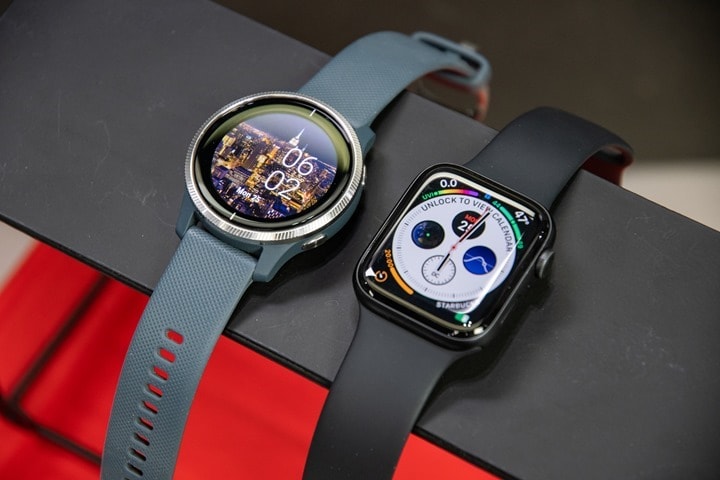
I’ve added the Apple Watch Series 5 into the product comparison database, allowing you to compare it against other products that I’ve reviewed in the past.
For the purposes of below I’ve compared it against the Fitbit Ionic, Samsung Galaxy Active Watch 2, and the Garmin Venu – which are the ones most people will be comparing it against from a sports/fitness standpoint. Also note, with a unit like the Apple Watch specifically, there are many cases below where “with 3rd party apps” can be used. The same is largely true of Garmin, Samsung, and somewhat with Fitbit. I’ve tried to thread the needle of apps that I roughly know exist where I’ve listed that. But it’s not perfection in terms of knowing every app on earth. Ultimately, I don’t think any consumer does (or should). Plus, we’ve actually seen a pulling back of wearable apps from companies over the last year (basically, they stop updating them). Making it even harder to know an up to date app from a dysfunctional one dying on the vine.
| Function/Feature | Apple Watch Series 5 | Garmin Venu | Samsung Galaxy Active | Fitbit Ionic |
|---|
| Copyright DC Rainmaker - Updated October 18th, 2023 @ 10:11 am New Window |
| Price | $399/$499 (cellular) | $299 | $199 | $229 |
| Product Announcement Date | Sept 10th, 2019 | Sept 5th, 2019 | Feb 20th, 2019 | Aug 28th, 2017 |
| Actual Availability/Shipping Date | Sept 20st, 2019 | Sept 5th, 2019 | Mar 9th, 2019 | Oct 1st, 2017 |
| GPS Recording Functionality | Yes | Yes | Yes | Yes |
| Data Transfer | Bluetooth Smart | USB, BLUETOOTH SMART, WiFi | Bluetooth Smart | Bluetooth Smart |
| Waterproofing | 50m | 50 meters | 50 meters | 50m |
| Battery Life (GPS) | 6hrs GPS on time (18hrs standby) | 20 hrs (just GPS), up to 6hrs GPS+Music | Undeclared (claims 45hrs non-GPS) | 10 hours |
| Recording Interval | Varies | 1s or Smart Recording | 1-second for GPS, 1-minute for HR | 1-second |
| Alerts | Vibration/Audio/Visual | Vibrate/Visual | Vibrate/Visual | Visual/Vibrate |
| Backlight Greatness | Great | Great | Great | Great |
| Ability to download custom apps to unit/device | Yes | Yes | Yes | Yes |
| Acts as daily activity monitor (steps, etc...) | Yes | Yes | YEs | Yes |
Music | Apple Watch Series 5 | Garmin Venu | Samsung Galaxy Active | Fitbit Ionic | | Can control phone music | Yes | Yes | Yes | Yes |
| Has music storage and playback | Yes | Yes | Yes | Yes |
| Streaming Services | Apple Music | Spotify, Amazon Music, Deezer | Spotify | Pandora, Deezer |
Payments | Apple Watch Series 5 | Garmin Venu | Samsung Galaxy Active | Fitbit Ionic | | Contactless-NFC Payments | Yes | Yes | Yes (but only with Samsung phone) | Yes |
Connectivity | Apple Watch Series 5 | Garmin Venu | Samsung Galaxy Active | Fitbit Ionic | | Bluetooth Smart to Phone Uploading | Yes | Yes | Yes | Yes |
| Phone Notifications to unit (i.e. texts/calls/etc...) | Yes | Yes | Yes | Yes |
| Live Tracking (streaming location to website) | With 3rd party apps | Yes | No | No |
| Group tracking | No | No | No | No |
| Emergency/SOS Message Notification (from watch to contacts) | Yes | Yes | No | No |
| Built-in cellular chip (no phone required) | Yes (with cellular version) | No | No | No |
Cycling | Apple Watch Series 5 | Garmin Venu | Samsung Galaxy Active | Fitbit Ionic | | Designed for cycling | Yes | Yes | Yes | Yes |
| Power Meter Capable | No | With some Connect IQ apps | No | No |
| Speed/Cadence Sensor Capable | No | Yes | No | No |
| Strava segments live on device | No | No | No | No |
| Crash detection | Yes via 'Fall Detection' | Yes | No | No |
Running | Apple Watch Series 5 | Garmin Venu | Samsung Galaxy Active | Fitbit Ionic | | Designed for running | Yes | Yes | Yes | Yes |
| Footpod Capable (For treadmills) | With 3rd party apps | Yes | With 3rd party apps | No (but has treadmill functionality) |
| Running Dynamics (vertical oscillation, ground contact time, etc...) | No | No | No | No |
| Running Power | With 3rd party apps | No | No | No |
| VO2Max Estimation | Yes | Yes | No | Yes via app |
| Race Predictor | No | No | No | No |
| Recovery Advisor | No | No | No | No |
| Run/Walk Mode | With 3rd party apps | Yes | With 3rd party apps | No |
Swimming | Apple Watch Series 5 | Garmin Venu | Samsung Galaxy Active | Fitbit Ionic | | Designed for swimming | Yes | Yes | Yes | Yes |
| Openwater swimming mode | YEs | No | Yes | No |
| Lap/Indoor Distance Tracking | Yes | Yes | Yes | Yes |
| Record HR underwater | Yes | Yes | Yes | No |
| Openwater Metrics (Stroke/etc.) | Basic stroke type only | No | No | No |
| Indoor Metrics (Stroke/etc.) | Basic stroke type only | Yes | Yes | Yes |
| Indoor Drill Mode | No | No | No | No |
| Indoor auto-pause feature | Yes | No | No | No |
| Change pool size | Yes | Yes | Yes | Yes |
| Indoor Min/Max Pool Lengths | 1y/m to 1,500y/m+ | 13M/15Y TO 150Y/M | | 10m/y-100m/y |
| Ability to customize data fields | Very limited | Yes | | Yes |
| Captures per length data - indoors | Yes | Yes | Yes | |
| Indoor Alerts | Yes (goals) | Yes | No | Yes (distance) |
Triathlon | Apple Watch Series 5 | Garmin Venu | Samsung Galaxy Active | Fitbit Ionic | | Designed for triathlon | Not really | No | No | No |
| Multisport mode | Yes | No | Sorta (can combine sports manually) | No |
Workouts | Apple Watch Series 5 | Garmin Venu | Samsung Galaxy Active | Fitbit Ionic | | Create/Follow custom workouts | With 3rd party apps | Yes | No | No (Premium Coached only) |
| On-unit interval Feature | With 3rd party apps | Sorta (Pre-loaded) | No | No |
| Training Calendar Functionality | With 3rd party apps | Yes | No | No |
Functions | Apple Watch Series 5 | Garmin Venu | Samsung Galaxy Active | Fitbit Ionic | | Auto Start/Stop | Yes | Yes | Yes | Yes |
| Virtual Partner Feature | Sorta (Pacing feature) | No | Pace guidance only | No |
| Virtual Racer Feature | No | No | No | No |
| Records PR's - Personal Records (diff than history) | No | Yes | No | No |
| Tidal Tables (Tide Information) | No | No | No | No |
| Weather Display (live data) | Yes | Yes | Yes | Yes |
Navigate | Apple Watch Series 5 | Garmin Venu | Samsung Galaxy Active | Fitbit Ionic | | Follow GPS Track (Courses/Waypoints) | With 3rd party apps | No (but some 3rd party apps can) | No | No |
| Markers/Waypoint Direction | With 3rd party apps | No | No | No |
| Routable/Visual Maps (like car GPS) | With 3rd party apps | No | No | No |
| Back to start | With 3rd party apps | YEs | No | No |
| Impromptu Round Trip Route Creation | With 3rd party apps | No | No | No |
| Download courses/routes from phone to unit | With 3rd party apps | NO | 3rd party apps | No |
Sensors | Apple Watch Series 5 | Garmin Venu | Samsung Galaxy Active | Fitbit Ionic | | Altimeter Type | Barometric | Barometric | Barometric | Barometric |
| Compass Type | Magnetic | Magnetic | N/A | N/A |
| Optical Heart Rate Sensor internally | Yes | Yes | Yes | Yes |
| SpO2 (aka Pulse Oximetry) | No | Yes | No | |
| Heart Rate Strap Compatible | Yes | Yes | 3rd Party Apps only | No |
| ANT+ Heart Rate Strap Capable | No | YEs | No | No |
| ANT+ Speed/Cadence Capable | no | Yes | No | No |
| ANT+ Footpod Capable | No | Yes | No | No |
| ANT+ Power Meter Capable | No | No | no | No |
| ANT+ Lighting Control | No | Yes | no | No |
| ANT+ Bike Radar Integration | No | Yes | No | No |
| ANT+ Trainer Control (FE-C) | No | No | No | No |
| ANT+ Remote Control | No | No (Yes for VIRB camera control) | No | No |
| ANT+ eBike Compatibility | No | No | No | No |
| ANT+ Gear Shifting (i.e. SRAM ETAP) | No | No | nO | No |
| Shimano Di2 Shifting | No | No | No | No |
| Bluetooth Smart HR Strap Capable | Yes | YEs | 3rd party apps only | No |
| Bluetooth Smart Speed/Cadence Capable | No | Yes | No | No |
| Bluetooth Smart Footpod Capable | No | Yes | 3rd party apps only | No |
| Bluetooth Smart Power Meter Capable | No | No | No | No |
| Temp Recording (internal sensor) | No | No | Yes | No |
| Temp Recording (external sensor) | No | Yes | No | No |
Software | Apple Watch Series 5 | Garmin Venu | Samsung Galaxy Active | Fitbit Ionic | | PC Application | None | Garmin Express | No | PC/Mac |
| Web Application | None | Garmin Connect | No | Yes |
| Phone App | iOS only | iOS/Android/Windows | iOS/Android (iOS is limited though) | iOS/Android/Windows |
| Ability to Export Settings | No | No | No | No |
Purchase | Apple Watch Series 5 | Garmin Venu | Samsung Galaxy Active | Fitbit Ionic | | Amazon | Link | Link | Link | Link |
| REI | Link | Link | | |
DCRainmaker | Apple Watch Series 5 | Garmin Venu | Samsung Galaxy Active | Fitbit Ionic | | Review Link | Link | Link | Link | Link |
Again, remember you can make your own comparison charts here using the product comparison tool/database.
Summary:
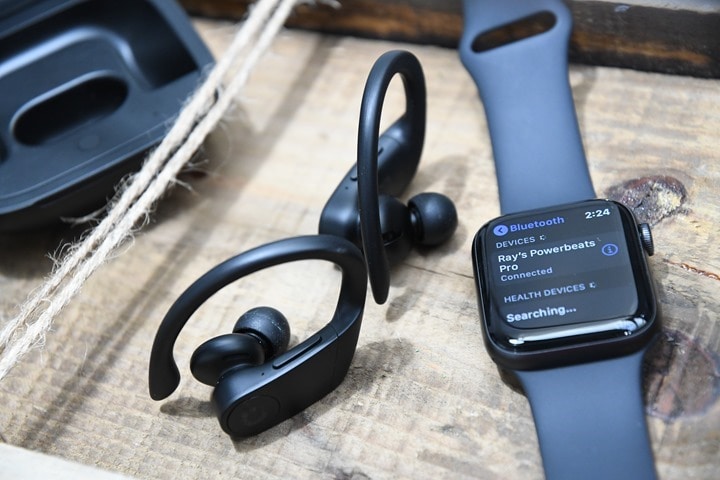
The Apple Watch Series 5 is a great all-around smartwatch. In fact, it’s probably one of the best smartwatches. But I’m actually not convinced it’s the best smartwatch Apple’s ever made (or anyone else for that matter). In fact, I actually think the Apple Watch Series 4 might take that crown. While the always-on display of the Series 5 is nice, it’s come at a solid hit to battery life compared to the Series 4. While the official specs often didn’t convey it well, the Series 4 actually easily got 2 full days, sometimes even into the 3rd day. The Series 5 simply can’t last 24 hours, and that’s before we apply a workout to it. It’s official spec is 18hrs, and even delivering on that can be tough depending on the day.
Yes, the Apple Watch series (irrespective of model) is a fantastic non-fitness watch. Easily the best out there, if you’re on iOS already. The integration within Apple’s ecosystem is incredibly well executed, and all the little bits mostly work. I say mostly, because as anyone will have pointed out, the blend of iOS13 and WatchOS6 has been rough these first two months, however, things have started to stabilize. It’s been at least a few weeks since the watch did funky things like randomly restart or lose notifications for half the day without reason. It’s acting like it should now.
And if I ignore the battery hit, the always-on display of the Series 5 is by far the best executed, namely in terms of nighttime viewing. Albeit not 3rd party apps. The barely visible but still functional nighttime glow of the screen nails it, compared to competitors that still end up having a bright spotlight of an always-on display under the sheets in bed. I just wish Apple would have launched it with 3rd party support. I’m sure in time it’ll come.
So in summary, for sports and fitness – the Series 5 is mostly as good as the previous units. Which means for many people it’s all they’ll need to get/stay in shape, train for a race, or even compete in that running race. You can do all those things with the Apple Watch just fine. But, other sports/fitness wearables will cater to those things better, more natively. And if you’re looking to go hiking or climbing in extreme weather – this really isn’t the watch for that. But it’s a fantastic watch for day to day life.
With that – thanks for reading!
Found This Post Useful? Support The Site!
Hopefully you found this review/post useful. At the end of the day, I’m an athlete just like you looking for the most detail possible on a new purchase – so my review is written from the standpoint of how I used the device. The reviews generally take a lot of hours to put together, so it’s a fair bit of work (and labor of love). As you probably noticed by looking below, I also take time to answer all the questions posted in the comments – and there’s quite a bit of detail in there as well.
If you're shopping for the Apple Watch Series 5 or any other accessory items, please consider using the affiliate links below! As an Amazon Associate I earn from qualifying purchases. It doesn’t cost you anything extra, but your purchases help support this website a lot.
Since the Apple Watch Series 5 is no longer sold, I recommend looking at
Apple Watch Series 9:
Here's a few other variants or sibling products that are worth considering:
And of course – you can always sign-up to be a DCR Supporter! That gets you an ad-free DCR, access to the DCR Quarantine Corner video series packed with behind the scenes tidbits...and it also makes you awesome. And being awesome is what it’s all about!
Thanks for reading! And as always, feel free to post comments or questions in the comments section below, I’ll be happy to try and answer them as quickly as possible. And lastly, if you felt this review was useful – I always appreciate feedback in the comments below. Thanks!











































































































































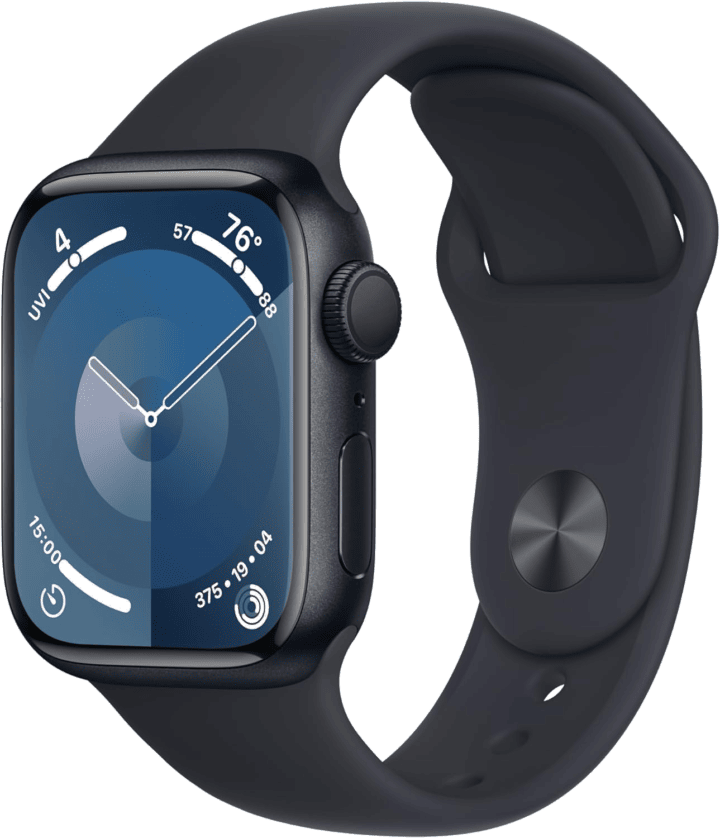
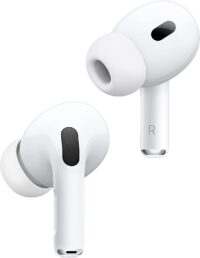















Thanks for the review and I am glad I stuck with my 4 and didnt upgrade to the 5. Right now its my go to watch even for run workouts (using the Stryd app mostly). I rarely use my old 735XT now and since there is an app that can use the bike powermeter, I think in general I am good (maybe swim workouts need some work).
Hi, im also a Garmin 735xt owner and I am looking at the Apple Watch 4 as an upgrade. Is it really a major step up from the 735?
For what? It’s a much better smartwatch. It isn’t as good a fitness device. If you have any ANT+ sensors you rely on, you’ll need to buy new Bluetooth sensors. If I were you, I’d buy the AW and keep the 735 for real activities. I have an AW5 and a Fenix 5+, and use them both. I almost never use the AW to record activities (done it exactly once using the Strava app), and almost never use the Fenix as a smartwatch. So it could be a step up or a step down, depending on what you want out of it.
When aw5 came out i was on the market for a new watch (well, i still am) and i almost pulled a trigger, since the integration with iphone would benefit me (greatly), but i am happy that i stuck with my garmin VA3. I think that 1 day (or less!) on a charge is just not practical for me. Yes, yes, you put on charger during the night, but sometimes i just forget about it.
I think i’ll wait for suunto to get do some progress on their firmware (wishful thinking) or polar to come out with a watch with music storage.
Thanks for another great review Ray!
Best regards from Slovenia, Z
Hi Ray,
thanks for the review!
One question, which is more about Apple Watch but also touches other wearables: considering that a wearable needs to get a GPS lock and a HR lock, what is the way of working you recommend: start the workout (e.g. run), then warm up for a minute or two and then actually run?
Considering that most wearables are smart enough to see that you’ve started a run but you’re not moving so they will just auto-pause – will GPS lock and HR lock happen when the wearable is auto-paused (or manually paused for that matter)?
It’s less of an issue for training but more of the issue for actual events.
It seems that doing a quick workout to establish HR lock, and then discarding it helps the most. But it’s imperfect. I did that for the track run, and it still missed the above.
GPS lock will lock faster if you stand still than if moving.
Discarding might help unless you’re with the Apple Watch, which doesn’t have a “Discard” button :(
Sadly, with WatchOS 6 / iOS 13 Apple Watch became quite independent, but some things can still be configured only via phone.
In Garmin, you can just start and cut off the activity afterwards in connect.
What I like to do is get a heart rate lock and GPS lock quickly by doing the following prior to exercise. My Apple watch 4 has a heart rate and location complication on the watch face that I use for workouts. I click on the heart rate complication to get an instantaneous heart rate and then click on the location complication which brings up a map and the GPS will then show where I am. Then I go ahead and click the workout complication and the workout that I want to do then 3, 2, 1 I have a robust heart rate lock and a GPS lock. These are extra steps but they do not not take that long. I hope that is helpful for someone who wants a more accurate heart rate at the beginning of exercise and a better GPS track. It works well for me when I choose to use it. I agree it is disappointing that Apple does not automatically lock these 2 things in prior to exercise.
Great review as usual, but you do not mention how it behaves for cycling, and how it compares to other watches for that purpose.
In my experiece, “Active Calories” count on cycling workout in workout app is too much reliant on achieved speed, so for example when I ride my fat bike on snow I get 1/3 of active calories I would normally get on a road bike (despite similar HR).
Also, you do not complain about activity rings and no way to have rest days without completely destroying workout statistics, or no way to mark sick days.
It seems to me that workout/activity part of the watch is significantly poorer than other parts.
I included cycling at the end of the GPS accuracy section. As far as how it behaves in terms of screens and such, it’s just showing the absolute basics. There aren’t a bunch of fancy fields like cycling cadence or power meter support natively (but you can use the Train2Peak app or CycleMeter, which I showed as well).
I didn’t complain about the inability to set rest days or sick days because honestly no other wearable has that functionality either. I think it’s a cool concept though, but it’s hard for me to give Apple a hard time for it when it simply doesn’t exist anywhere today from anyone, to my knowledge.
“It seems to me that workout/activity part of the watch is significantly poorer than other parts.”
Yup.
“I didn’t complain about the inability to set rest days or sick days because honestly no other wearable has that functionality either. I think it’s a cool concept though, but it’s hard for me to give Apple a hard time for it when it simply doesn’t exist anywhere today from anyone, to my knowledge”
Yup, but no other wearable, as far as I know, has so much emphasis on awards and badges – for example, there is an award for “perfect week” which you get when you meet yours daily goals whole week, and award for longest move streak in days. So you can imagine frustration when you are sick or out of the training due to bike crash…
Great review. A couple of points:
1. There are far more workout types available in WatchOS6 – in the Activity app, keep scrolling down and you can choose ‘Add Activity’ to see the full list – over 100 types. (Including ‘fitness gaming’, my new favourite!)
2. The compass is useful when using the Watch to navigate on a run when somewhere new – previously you had to try to work out which direction to do by using road names or landmarks visible on the map screen – now the map orients itself correctly.
Thanks,
Paul
Thanks!
1) Dang, I never knew you could access more sports that way. Sweet! Updated.
2) Yeah, that’s true. I think I personally still tend to navigate via landmarks, except up in the mountains.
Cheers!
Annoying part that all those workouts are basically a replacement for old-style “Do an Other workout, assign a sport afterwards”, as they all don’t use GPS. Quite annoying, actually, as there’s no native way of tracking nordic skiing or kayaking on Apple Watch.
But it is nice that you can create presets beforehand (and you can also remove said presets via swipe)
but no gps with all of them! which makes it quite unuseful eg for „skiing“, but eg for „Pilatrs“ is nice
I have a series 4 and while I like it the 645 music is £200 at Argos atm and I’m quite tempted to try it, I just wish garmin or a third party app was able to match the podcast support the Apple Watch has, I have high hopes for the next watch in the 600 line
Yup, I agree. The way podcasts are handled on the Garmin watches today (unless you leverage Spotify or such), is very 1999. Which is funny, because the rest of the music platform aspects is industry leading from an underlying structures standpoint.
I’m Android user since very begging of the Android platform, and Garmin watches user since early Forerunner ones, now Fenix line user. But Apple Watch might be the reason that will eventually make me drop Android and switch to IOS.
Great content as always.
Can we expect to see the Garmin Venu in depth review before Black Friday ?
Im still undecided on a nice looking watch to help me track runs.
Cheers.
Me too. I think Garmin Venu sales will have a slight, but noticeable, increase or decrease depending on DC’s review release/not release and positive/negative view.
It’s my hope as well. I’m trying!
Weird thing is that if you choose workout as “other” then later it’s not possible to rename it anymore, as far as I know, it was possilbe in the past.
There’s also very limited to configure the “view screen” for different workout profile, speed, distance etc.
Otherwise great everyday watch, but for training I prefer Suunto or Garmin.
Comprehensive review, as always. Although not unique to AW5, I find VO2 max very disappointing. Values are invariably higher than Polar or Garmin, and don’t even trend with the others. On the positive side, the Breathe function produces HRV values that are in line with Polar, Garmin, and can be used by apps such as HRV4training. Again, these comments pertain to both AW4 and AW5. Also, do you see a difference in HR sampling rates when comparing always on display to normal raise to wake?
On my AW3 I am able to see steps and distance on my watch face via the free pedometer app. I added the pedometer app to the “Bottom” setting of my watch face.
But yes I agree this is something that Apple should make available without a third party app.
It’s mostly due to the fact that Apple does not consider step information vital (and to be fair – rightfully so – if I’m biking for the whole day, I’ll end up with ~2k steps.
That’s why they use calories as main activity metric vs steps that Fitbit use.
But?? why do you have a bike cassette as picture nexto the watch?
Cycling is a sport. Also, it looks pretty.
Re: steps – it makes me wonder if Fitbit has a patent on displaying steps on a watch face. That’s the only logical explanation considering steps are shown in Health.
Garmin and others show it. Actually, basically every company I’m aware of it can display it…except Apple.
I got the Apple Watch Series 5 and I think it’s a great watch. I got the WorkOutDoors app for $5.99 and it give the AW just about all the functionality of the fenix as far as workouts go. I’m just an old guy trying to stay healthy and don’t need all the advanced features that athletes need.
I have owned every fenix since the 3, and it seems like they are just getting buggier and all the advanced features never where consistent for me. I could do the exact same workout on the same course at the same intensity and get 2 completely different set of data. And the training status for the most part seems to tell me I’m not doing good enough which makes me beat the crap out of myself even more, and that’s still not good enough.
For example I did a 12 week half marathon training plan that required all the runs to be at a slow (70% of MHR) pace. Every run I got bad training status and my VO2max plummeted from the top end of good the poor. Just very frustrating.
I appreciate your reviews, but I think this one you seemed to pick apple apart at every turn, and I think it is an awesome device for the regular person just trying to be at a decent fitness level.
I think apples software is leaps and bounds ahead of garmins in the bug department. I mean hell, the user forums have become garmins testing department, and the majority of there beta’s that they post on the forum wind up breaking more than they fix lately.
~just sayin dude~
The main problem of all Apple Watch generations is battery life. It’s OK for “normal” sports (there’s even a guy blogging about his triathlon experiences with Apple Watch and Wahoo ELEMNT – he is able to do it on a single AW charge), but when you walk into long-distance stuff (ultra-runs or backpacking), then you need something else. Simple example: when hiking, I charge my AW4 during the morning breakfast/packing routine to 100% and I have to charge it again somewhere midday (despite being set to Airplane mode with all communications shut down) – otherwise by the time I get to a next camp spot, the watch will be dead and I won’t have any track. I can probably get an extra hour by disabling optical HR as well and relying on HR chest strap, but I’d have to charge it before campsite nevertheless. And charging AW on the trail is even worse than charging a Garmin (I’ve never tried charging Garmin on the trail, but I’m certain that the AW charging experience is by far the worst).
If somebody invents a way to charge AW on the wrist on the go or at least give it 15+ hours of GPS recording – I will be the first person standing in line to buy it.
Anyway, the app suggestion is good, I might give it a try!
Hi Bob-
Looking at the specific issue around a low-pace training plan, I’m actually not uncertain the algorithm would have been wrong there. Low-speed long runs in marathon/etc plans are common (I did them as part of a few years of training, and they work really well). However, that’s just the long run. You would still need high intensity somewhere in that week in order to achieve gains aerobically, which is ultimately what VO2Max is all about.
Meaning, I think the Garmin was actually correct here. I can’t think of a specific physio-driven reason they wouldn’t be – again, based on the little snippet you provided.
As for bugs – absolutely – Garmin is buggy, see my post back in June on that*. However, so was Apple this time around. Really bad in fact. My first impressions notes some serious HR accuracy issues that other reviewers pointed out as well. Yes, they’re fixed now – but that wouldn’t have been the case if I just published it 7 days later. And that of course totally ignore iOS13, which was required for Apple Watch Series 5, so you bundle that mess of an experience together and it’s frankly just as bad as Garmin.
Ultimately, this review is a fitness/sport review – and one can’t really overlook the fact that all Apple did this year in that specific category was reduce battery life, add an always-on display that doesn’t work with 3rd party apps, add new fitness trending pages that don’t work for 6 months, and give you two new data fields. Of course, inversely, from a smartwatch standpoint (non-fitness) there were tons of new features and even new useful hardware changes (like the emergency bits being international now).
I agree about the battery life, but my average daily workout is usually only an hour or two. I do go on hikes that may last 4 hours or so. I can always throw a charging pack in my backpack and charge during breaks though.
I realize it’s a fitness review, but I think you geared it more towards athletes then just regular folks like me. I do at least 1 activity a day 7 days a week, but I will never be an athlete, and there are many people like me that buy these products. I think the AW is an extremely great product for health and fitness for regular people.
As far as the software and the native fitness apps go, I think there is room for improvement there too, but the real advantage with the AW is to find the right apps for what you need to fit what you do. That is something you can’t do with any other fitness wearable. For example… the WorkOutDoors app gives the apple watch just about all the functionality of the fenix as far as workouts and navigation goes, and it only costs 6 bucks, and the map works better than it does on my F6X Pro. You can also load sections of the map right to the watch for off line use as well as load courses. It also syncs seamlessly with the health app and the activity app the same as if you used the native workout app to record the workout.
my point is that with the right apps you can turn the AW into an awesome fitness device even for some athletes (ones that don’t do ultras for example). I’m sure apple know this and maybe that’s why they are not in a rush to add those features to their native apps, and that is a very important point that you could have brought up in your review I think.
I personally don’t think there is another wearable on the planet that could match the AW as far as that goes, and the biggest drawback to the AW is the battery life.
I do enjoy your reviews and glad to have someone like you that takes the time to inform people, but I think you could have brought up the points of getting the right apps as that is the AW’s strongest asset.
Excellent!
Thank you!!!
I’m not sure, but I suspect iSmoothRun has so far recorded cycling power directly „watch only“ (without iPhone). I am very happy with the watch. Only because of the third-party apps that are not “always on” is a great pity. Did some tests (in german):
link to youtu.be
Hmm, when you did the test with iSmoothRun for power meter data – did you do it without any phone on you (even with a phone nearby in airplane mode, the Apple Watch will actually override that in some cases)?
Hi Ray,
Great review as usual. One question that I don’t think I saw answered. In terms of the main downside, Battery life vs. the Apple Watch Series 4, what impact does have turning the always on display off?
That is with the display set to work in the same way as the Series 4 do you get similar battery life or does the Series 5 have less battery life regardless?
Cheers,
— Colm.
I bought my AW5 on release day. I quickly turned off always on because it was a big drain on the battery. After several revisions of WatchOS, I turned it back on and it’s not much of a problem any more. My AW3, even after two years of daily use, showed about 60% on a typical day as I took it off for the night. My AW5 with always on shows about 40-50%. Always on is nice to have, and doesn’t have much impact on battery life any more, but if I had to turn it off again I really wouldn’t miss it that much.
Thanks for the nice review, Ray. I’ll keep my AW4 for now.
BTW, I never knew why the AW4 needed about 5-10 minutes for the HR to kick in when doing a pool swim until I read this review. That is more frustrating to me than the limited battery life.
Ray, a quick question about always on. Does this feature work while swimming? Or is that not function when under water?
Yup. Essentially any ‘Workout’, using the official Apple ‘Workout’ app, supports always-on. Inversely, just about everything else doesn’t (except the watch face). There are a handful of Apple apps that do support it, but most don’t.
Thanks DC Rainmaker for the comprehensive and insightful review. Pleased to hear the heart rate issues have been resolved via software update since your ‘first impressions’ vid.
From a runner’s perspective, the Apple Watch is highly appealing in terms of LTE. Really like the idea of being able to stream music and listening to podcasts, particularly on long runs. Are you able to comment on the user-experience with cellular – functionality, battery life?
What’s Apple native HIIT app like – could this be used to do running intervals/speed sessions? As you say, strange Apple don’t support interval training natively for running.
Think I’ll keep my trusty Garmin Forerunner 245 for the intervals/structured workouts (Garmin Connect is great for programming all sorts of run workouts that you can download directly to the watch) and perhaps use the Apple Watch for the easy and longer workouts, with the option to stream Apple Music/podcasts. Looks like the HealthFit app will enable me to do this and export to Strava.
Thanks again for the fantastic review. :-)
Hi Ray,
Thanks as always for the great review. Two questions (well, comment and a question):
First – loved your comment: “Still, I’m surprised that we’ve yet to see Apple add any basic interval or structured workout support.” I keep hoping they’ll add this every year. For me personally, it’s basically the one thing the watch lacks, and the 3rd party app options are not great or are tied to other devices (in some cases). Maybe next year?!
Second – you list in your product comparison table a “yes” for multisport mode. Are you referring to the ability to change to a different activity type from your active one? Or did I miss something? Because if they somehow snuck in an update to add a multisport mode similar to Garmin’s that would be amazing!! (Unlikely I know, but I can hope!)
Thanks for all that you do! Happy Thanksgiving and best wishes with the DCR Open House this weekend!
Do you have any tips on getting good HR when running? I get mixed results, I think having the watch slightly higher on my wrist and tightening the Velcro strap seem to be key.
As always great review Ray. I made a switch to AW5 from fenix 5 and I thought I would miss Garmin’s watch more but it’s not the case. With my ocassional runs and basketball games I think that smartwatch just suits me better than sportwatch. But who knows, maybe after few months I’m going to miss all this stats from fenix ;) But I still have Edge for my bike ;)
As for the battery with Apple Watch 5 it’s strange. I can get it to last 24 hours (without any workouts) and still have some juice in the morning (around 15-20%). Maybe something is wrong with battery in early models?
Wow, not being able to display steps would be a deal breaker for me too. That is definitely not nit picking, and it is not something I would have expected at all, so not even something I would have thought to check before buying. I think this may be even more important for people who aren’t fitness enthusiasts or naturally very active people. If I cycle to work that burns quite a few calories, but that does not mean it is therefore okay to just sit on my butt all day. Walking burns very few calories per minute, so focusing on calories gives people the impression that it is smarter to do other things. I think that is misguided. It is not smarter to cycle 10 minutes on your exercise bike when you get home at night than it is to go for a 30 minute walk during lunch, even if the cycling burns more calories.
Except as several people on here have explained, you CAN add steps to the watchface with the pedometer++ app
I have used Apple products for a while and apps break way too often. Basically none of my all time favorite iPad games still work. For my Garmin watch I don’t use that many apps, but there too I have seen apps that stop working. Apps are fine for nice to haves but I would not rely on them for a feature that is important to me. But I don’t buy a new watch every year. If I did that, having it available in an app would probably be good enough indeed.
Duffy presents also steps on the watchface. Very nice pedometer app.
Sorry f it’s a dumb question but
Is it possible to pair it with the polar chest HR strap and using the polar app get all the data from polar?
Does it unable polar features like stress evaluation, VO2, fitness lvl etc?
I ask because I keep looking for a watch and Even though I like more the polar website interface and the watch features, I still think it’s hard to find a watch that get the design aspect as well as the apple watch.
Also the health features on the apple watch 5 are interesting.
I only wonder how much of that good data (which garmin and polar give) we can get.
Nice review Ray. I’m curious about the ECG tracing. Was the watch set to be on your left wrist but you had it on your right wrist when you took the ECG? The ECG tracing is inverted; those QRS complex’s should be upright.
Ahh yes, that’d probably be the case – normally I wear it on my left, but for that photo I put it on my right. Interesting, I had wondered why they were opposites. :)
Please, can someone confirm the 20h gps batery time on the Garmin Venue, i can’t belive that no one talk about that. I want a smartwatch with oled screen and alway on, and a good watch to do my trail running race. And for me 20h batery is the minimum.
Did the heart rate accuracy vs Apple watch Series 4 ever get resolved? One wonders why such a successful feature would get worse with an improved product.
Thanks for another great review Ray! Completely understand wanting to keep the review simpler and purer by sticking to the stock Apple Workout app. It really leaves a lot to be desired and I’m a bit shocked at how much Apple has neglected this part of the watch.
Really glad to see you mentioned WorkOutDoors here, though, as there have been a TON of enhancements made since you did the AW4 review and, IMO, it really transforms the AW experience. The current version (v4.1.3) covers a huge number of indoor/outdoor sports, uses buttons to take splits/intervals and provides a MASSIVE amount of customization capability for screen layouts, data metrics, etc. as well as support for scheduled/structured workouts. Highly encourage people to check it out!
Get Huwaei Watch GT 2 . it is has a unique 2 weeks strength advantage, worth your time to review it :)
Thanks. Any thoughts on whether auto pause will be enabled for cycling workouts?
Thanks DC for both your current and initial unboxing reviews. After reading your unboxing, I went for AW3 and do not regret it. HR is more reliable than my vantage M, especially when paddling in sea (salt water).
QUESTION: my wife wants to get a AW, but currently the options are either AW3 or AW5, no AW4. Besides, regular training we like to go on half/whole day hikes. Would AW3 our perform in terms of battery life still? What would one miss out on when opting for AW3? It seems the only benefit is always on and a “better” HRM.
Hi! I received this watch as a gift; one of my sons thought it would be a great integration with my iPhone and iMac. Funny thing, no one would call me a serious athlete … and yet, I do interval training and like to share my stats with my chiropractor who helps me figure out “what next”. I was sorely disappointed to find that I could not program the watch in seconds for interval training (simple things, like hill work … or sprints at 65 seconds) (see, not an athlete yet this stuff is so important for overall health). My son suggested there was an app for that. What isn’t clear unless I invest in an app, is whether the app data will be counted within the watch data. It was also disappointing that without investing in another app, I can’t actually share my data with my coach. I felt like for $600 Cdn these are pretty basic fitness things. So, your site helps me better understand the watch’s limitations and whether, for me, a more basic watch (to also cover swimming in pools) is enough (better for training, not a lifestyle watch). In fact, those iWatch notifications bug me so much, some days I don’t wear the watch because I don’t want to be “watched”, you know? (Yes, I turned them off, but it’s still watching even if it doesn’t tell you.)
You can do timed interval training with pace, heart rate or running power targets with iSmoothRun. It works great, and costs $6 on the App Store. Integrates with Apple Health and the Apple Watch sensors, so no different than using the native workout app for sharing with others. And yes, the data count as “watch data.”
Thank you!
Does it count against the challenges? I remember, that for “7 workout challenge” in the past (watchOS 4 & 5) workouts had to be recorded via native workouts app.
Yes, they count towards challenges.
Fabulosooooooo?
Had a i Watch 3 for a short time because of developing a skin rash from both the watch band and back surface of the watch itself. Found a after market bands took care of the rash but still had the rash from the back of the watch. Contacted Apple but was told they couldn’t (or would not do anything to help) so no refund etc. Is the new 5 made of the same material as the 3?
Cheers.
From what I know the 5 has a ceramic back which is different to the 3.
I’m curious, is there anyone currently still living (happily?) in a “dual ecosystem” setup? My situation is I moved from Garmin Forerunner/Fenix devices to an Apple Watch 4 when that was released, and haven’t looked back since. Upgrading to the AW5 has been fine once past all of the early software issues. The driving issue at the time for me is I think Apple Health and its full lifestyle focus (sleep, meditation, calories tracking, etc) worked a little bit better (for me) than Garmin Connect and its generally better fitness focus approach. Also, as several AW fans have mentioned, it’s all about the apps that can put the mediocre native apps to shame depending on your needs (for me, it’s Stryd app with my power meter managing structured workouts sent over by TrainingPeaks, easily streaming music or podcasts through LTE).
While this has been fine, I’m thinking about moving to distances beyond marathons later this year, and that’s were I think the AW just falls significantly short, and I could see the need to have a second device like a Garmin for longer workouts only. I’m specifically curious if those who may have both an AW and a Garmin can get those workouts into both ecosystems easily without “syncing issues”, duplications, etc.? It used to be a nightmare several years ago, and a simple Google Search seems to suggest there’s still a lot of problems.
Sorry, I think I answered my own question, at least for the basics: the HealthFit & RunGap apps Ray mentions in the review appear to be the way to move workouts from one platform to the other, but only workout activities apparently. I couldn’t see a way to get any other lifestyle data such as sleep or steps to sync over.
HealthFit can export general metrics (sleep, steps, HRV, RHR) to several services like FinalSurge, SportTracks, Today’s Plan and TrainingPeaks)
Yup, saw that. But it appears HealthKit doesn’t have Garmin Connect as one of its platforms, whereas RunGap does.
Thanks for replying. There doesn’t appear to be much comprehensive information on the web when you Google Search about moving full data around easily from ecosystem to ecosystem. My sense is people are less concerned about this than they were in earlier years, and tend to decide what walled garden they want to play in and commit to that.
Hi Charles,
I’ve talked to HealthFit developer multiple times, both before and after Garmin Connect API was made public. He doesn’t want to reverse-engineer API (so only official API calls), but from the looks of said API it’s “public”, but only available to certain big players, not individual developers.
Regarding the workout app not recording HR data for the first few minutes, I found that turning off the settings to automatically sense a workout and remind you to start or end it fixed this issue. I guess it kind of makes sense; if your HR is not elevated at the start of a run, the watch might be trying to assess whether you have ended the workout and forgotten to end it manually. I mean, it’s a bit stupid if that is the case, but it’s a potential explanation. At least, since turning off those “auto-sense” options I’ve had full HR data for the entire workout.
Great review but I have 2 questions related to the Native Swimming mode –
1. How apple calculates the average pace shown in the workout summary? In my prev. watch (garmin), my pace was around 1:35 / 100m – now, in the Apple Watch its way higher, around 2:00 most of the times. Why is that? Couldnt find anywhere in the Internet an answer to this question.
2. Is there a workaround for drill mode? how come apple are not adding it?
Thanks a lot,
Keep on rockin’!
Personally I switched from an Apple watch 3 towards a Garmin device. One month ago I’ve switched back to an Apple watch series 5.
Garmin is perfect as a core performance device but to my liking it’s just not as polished overall. I’m using the 40mm watch which is a perfect size for allround usage. (and slightly less present then a big Garmin)
Battery life is okay and perfectly workable (not having series 4 experience) for my usage but I tend to switch between always on and off.
For my activities I use a 3rd pary app called “workoutdoors”. 100% customizable and even lets you import GPX files to store offline on the watch. For me this app is really a game changer compared to the native workout app or the Strava app. (I’m not involved in the app in any way… Just a fan)
Just wanted to share this info…
Hi,
I’m struggling with the GPS for ocean swimming. I have the Series 5 and several others I swim with have Series 3 and 4 and a few have a Garmin. While mine does sometimes show the correct distance often it is twice the distance. Are you aware of others with this problem. None of the others I swim with have this problem. I have even worn two at once and it’s showing huge variations.
Thanks
Vicki
Vicki, I have the exact same issue. Have you solved this problem? (My tracks do those wild jigs as well, always at the beginning.)
I love my apple watch for everyday use and I don’t need much more out of it except …
1) a native triathlon activity in the workout app to use in a race
2) a better battery life that lasts for a longer race … maybe a bulky pro version?
Both seem easy and would prevent me (and others) from buying another watch/ having to charge both/ remembering to have the right one with me at the right time.
Swim distance alert? Hello, I’m hoping that someone here knows the answer to this, haven’t had much luck finding into on this. I currently own a Garmin FR 645 Music, and have been thinking of switching to an AW. However, one feature that I use very often is the swim distance alert (I’m terrible at keeping track of number of laps). Are there any 3rd party apps that would allow you to do this with the AW? Thanks!
Hi does anyone know if the series 6 or the new SE have vibration alerts for swimming eg number of laps/distance etc?
Great review as always Ray!
Question: with the Apple Watch utilizing the iPhone’s GPS if near by, will there be less drain on the battery during a long run?
Thanks!
definitely less drain – with phone nearby approximately 10% per hour
Thanks John! That answer has seems obvious but I haven’t found anyone state it and people at the Apple store seemed confused by it.
Awesome review as usual
I have been wearing Garmin Watches for the last 10 years but after a few months wearing the apple watch I can’t go back to Garmin – The integration with the iPhone is flawless, I can move freely around the house without worrying about “where is my phone”. Fitness wise is not as capable as a Garmin no question about that but it’s capable enough to support most people fitness tracking needs.
I’m still surprised that Apple hasn’t integrated intervals into their running software. It’s the exclusive reason why I continue to use Garmin. Well, battery life is also another factor (c’mon Apple; this is embarrassing!). Thanks for the review, Ray.
My watch the Nike series 5 with LTE activated keeps losing GPS- Mile 1 it was pretty close to my garmin, then after that it showed me all over the place. the distance was off .25 mi over a 2.25 mile run. It showed me running through houses and buildings. Any way to fix it- hardware or software issue?
Hi DC,
it seems that with the latest updates to watchOS they have gotten the heart rate sensor to work well again – as it did pre-watchOS 6. Any feedback from your side after the review above?
I did a workout yesterday with it. It seemed pretty good (interval/hill repeats). Perfectly accurate against a chest strap.
Any idea if Apple will ever open the Always On display option for third party applications? Given the Apple watch 6 is going to be release soon and the new Watch OS7 most likely will also be out. I’m surprise we still don’t have this ability for third party apps
Really like your elaborate review! Apple’s hardware design is unmatched… but the added features (from what we had in series 4) do not justify the huge increase in price… not at all.
Hello!
Thanks for this review, very helpful! Two quick questions:
1. Is there a way to force the watch to use its own GPS rather than the phone? I always have my phone with me while running and my current device (fitbit versa, which goes via the phone GPS) gets really lousy accuracy when I run. We’ve got very spotty cell service where I live and I wonder if that is contributing to my hideous mapping accuracy issues. Looking for a device with its own GPS to see if it solves my problem.
2. Say I am running with the strava app open but the screen will blur out as you noted above – can you “wake” the screen back up mid-run somehow? tapping or lifting wrist, etc? Or I’m better off just using apple’s native tracking app and then uploading the data into strava later?
Thanks again!
The one way that might work is to go to Settings->Bluetooth on your iPhone and turn off Bluetooth. So far as I know, whenever the iPhone is available the Watch will defer to it. By turning off Bluetooth, the Watch can no longer “see” the iPhone, and will be left to its own devices. I just tried, and my AW5 LTE is now saying it’s using WiFi instead of showing it’s connected to my iPhone. The other thing that might work is to turn on Airplane mode on the Watch. iPhone and AW are so symbiotically connected, though, that neither of these may work. It’s unlikely that the Watch will have better GPS than the Phone, though, because of the size difference. There’s more room in a Phone for a good GPS antenna. Not having cell service has nothing to do with GPS, but phones can improve their location accuracy by seeing what towers (which have known fixed locations) they’re seeing. Simply changing the orientation of the iPhone with respect to the sky might also help. But from what I’ve seen from the people I follow on Strava that use the iPhone app, the iPhone doesn’t have great GPS accuracy.
Yes, you can wake the screen with an arm raise or by tapping on it.
Thank you! So…it sounds like getting a new watch or a watch with built in GPS might not solve my problem? Literally every run I’m either getting gaps in recording (both from my fitbit watch or from phone based app like map my run, or strava or peloton…) or tracks that are way way off the streets I’m on, cut corners, etc. I frequently get back from a run with different pace/time/distance from multiple devices or apps for the same work out. So frustrating.
A different watch probably wouldn’t solve your problem. (Just read the reviews here of various watches; there’s always someone complaining about pace.) A foot pod might, but I’m not sure you can connect a foot pod to an Apple Watch. I use a Garmin Edge 830 for cycling and an Fenix 5+ for everything else (primarily cross country skiing and hiking). I use speed sensors (in reality, wheel rotation sensors) on all of my bikes to improve distance/speed accuracy, although at typical cycling speeds there’s only a real improvement if you’re also riding somewhere where GPS is problematic, as I do at times in the mountains of central Pennsylvania. It’s been my experience that the tracks from my Fenix don’t stand up under close scrutiny, although of course they’re not that far off my actual track. There’s a lot of jitter in the track. So your best bet to improve pace accuracy might be to get a foot pod and a watch to pair it to if the AW won’t.
Thanks! The thing I’m really hoping for is to be able to get accurate real-time pace. I just started a marathon training program and I’m trying to learn to maintain tempo pace during work outs…which is hard to do when I hit the gas and my watch tells me I’m running a 12:00 mile when I was previously cruising at 8-something and now feel like I’m in the 6-7:00 range based on perceived exertion (first world problem, I’m sure many people have run marathons based on feel without watches in the past!). Then get home and the map has a gap in recording and/or it’s pinging off some random place in a field…frustrating. I’ll have to look into the food pod. Is that similar to the Stryd device I’ve seen?
I’m not a runner, so all I know about foot pods is what I’ve read here at DC Rainmaker in various articles; of course I’ve never used one. The Stryd can do pace, but what it’s really for is “measuring” power output. Lower end pods can do the pace determination just as well, but they don’t do power (some Garmin watches do in conjunction with a pod or one of their running heart straps). Ray has lots of reviews of running watches and accessories, including the Stryd, at this site. As I understand it, pods simply count footfalls and then use your stride length (either what you’ve told it or a length determined from GPS over a distance which includes many strides) to determine your pace. So random GPS fluctuations don’t affect the measured pace.
DCR,
Is there a way to force the GPS to “Stick to the roads”.. kinda line plotting a course on mapmyrun? My 5 using iSmoothRun has me all over the place. Running around houses in my neighborhood… a loop in someones yard.. all while moving straight at a 6:40 pace.
My AW5 shows this behavior since I bought it. Only if cellular is active, whenever I switch cellular off, the GPS accuracy is quite good.
@DCR: could you have a look at this? AW5 cellular produces very wonky tracks. Reported the problem to Apple, intensive discussions but nothing happened. Watch is pretty useless to record tracks with LTE/cellular enabled.
There is a discussion at Macrumors on this:
link to forums.macrumors.com
Hi, I wanted to make you aware of an Apple Watch app, Training Today, that appears to be the equivalent of Garmin’s Body Battery. It takes HRV measurements from the watch with no user intervention to display a “Training Readiness” number on a scale of 0-10.
It even shows a 7-day chart with multiple measurements taken each day from the watch.
It is free to download on the App Store and was developed by “The Apple Watch Triathlete,” Ian Blackburn. See link to theapplewatchtriathlete.com for details.
I downloaded it a couple of days back and will see how it works for me.
Great to see people bringing added capability to Apple Watch for sports training.
Loaded the app, just finished a hard workout last night.. went hard this am… dying. App said 4.9. I thought that was accurate. Did the breathe app.. went to 6, did the breathe app a min later 8.8, waited a minute… did it again a minute later, got a 10. I’ll keep working with it.
It looks very much like it gets immediate data and makes predictions based on those. For example I woke up with 7.7 training ready, while I was doing my easy morning exercise it dropped to 6.6.
But the idea is cool. And it supports lots of different complication slots – problem for many Apple Watch apps out there.
I woke up at with a score of 8.0, felt good, so at least it reflected how I felt. Went for a 1 hour tempo run this morning, waited 10 min, did the breathe app and readiness is now 9.8. Funny thing is I felt more energized after the run than before, and it is interesting the score reflected it. As others have noted, this is more of a snapshot score than a body resource type readout from Garmin/Firstbeat.
While I might have been refreshed from an HRV perspective, I know I’m not ready for a difficult run right away. Will continue to track this for a few weeks – could be a useful tool together with training load metrics and for wellness tracking in general.
On a related note, we did a long night of star gazing over too much wine a couple of nights back and my readiness score was 0 next morning, recommending “Complete Rest.” I’ve got to say, it reflected how I felt (like crap) and interesting to see the full range of the readiness score over just a few days.
With the cellular version can you accept calls and messages when you are in swim mode. Thanks in Advance.
What I miss from all of your reviews is pace accuracy. I owned an Apple Watch series 2, and found it to be terrible for pace-based interval training because its pace estimates were all over the place when running. I would be very interested in knowing wether this has been improved over the years.
So, I am holding off for two months so I can get an AppleWatch 6, or pick up a 5 on the cheap. I notice that you wear yours on your right wrist, and that the crown is on the top right. That struck me as kind of awkward. I was thinking of wearing whichever model I get on my right wrist, but with the crown on the lower left side facing my fingertips so that it is more easily accessible. Do you have any advice or experience to offer on this topic?
Thanks much.
Adam Rodman
I can’t find it right now, but if I remember right it’s easy to invert the display to wear the watch upside down.
Ahh, there it is “Settings->General->Watch Orientation” You can choose which wrist you’re wearing it on, and independently you can choose which side the digital crown is on.
Hello, great reviews as usual, but I would like to provide a comment on the GPS accuracy for the Apple Watch 5 and also 4. Both are a complete disaster when you have the AW with cellular. It goes completely off track and my assumption is that the cellular module causes interferences to the GPS module in low signal strength situations. The result is that the AW4/5 is tracking up to 700m!!!! more on a 10km track, which is unacceptable. I started all my tests more than a year ago and uploaded several GB of log data to Apple. At a certain point, Apple support did not contact me…:-( Anyway, this is only seen on the AW4 + AW5 with Cellular and not with the AW3 and Cellular and can be reproduced anytime – interesting part here as well is if you turn off cellular and then do your run it all works fine. Also not related to the service provider as I have tested different ones + you are reading more and more in the web -> e.g. link to forums.macrumors.com
For me it looks like a HW design issue and I hope that the AW6 is not having this.
I second this. AW5 with LTE (cellular) enabled is absolutely unusable as GPS accuracy is WAY OFF of reality and the recorded tracks sometimes produces bizarre zig zags and such. Only usable with Stryd footpod to record correct distances and paces. With cellular off everything is fine.
One example of such a bizarre track with LTE enabled: link to forums.macrumors.com
Reported this issue to Apple but did not get further than level 2 support and nothing happened.
I “reopened” my ticket with Apple and will continue to push them…
Maybe you can add/reference my ticket numbers too. I opened one customer ticket and nothing happened after I spoke one hour with 2nd level support. Ticket seems also closed.
Also I opened a developer ticket through feedback assistent and I got a request for providing debug location data from my watch. Uploaded it with additional material (tracks, screenshots) but again, nothing happened.
My developer ticket: FB7720038
My customer ticket: 100957413719
Added one of the bizarre zig zags recorded with LTE enabled.
When you mentioned it’s worse for the always on display did you realize you could turn that off or was there some other reason it’s still bad despite being able to turn it off?
link to support.apple.com
Of course, but that sorta defeats the entire purpose of buying a Series 5 over any previous generation.
I may have read too quickly but for the open water swim the image says 935 for one of them but Ray is talking about the 945 in the next paragraph.
Mistake?
The Train2Peak app doesn’t seem to be available any longer. I’ve tried googling about it but can’t find any information at all.
Any idea of what has happened?
Regards
Erik
Thanks Ray!
I keep waiting for the cellular version coming to the Netherlands. That would be a big plus for me because I could leave my phone at home for long runs.
So, do you have any idea when will we be able to use the cellular version in the Netherlands?
I haven’t heard anything there unfortunately. :(
Does anyone know if you are able to pair a chest strap to the wrist unit for better accuracy. For training where accuracy on the wrist is compromised would prefer the chest strap – I use the polar H10. Or is this nester used in the native Polar app?
Yes, I have multiple chest straps that I use with my AW. Polar H10 und OH1, no problems.
Thanks, does this effectively turn off the optical sensors on the AW?
Not really sure actually. But as the HR data is obviously coming from the strap I never cared if the wrist HR is still enabled or not.
Ray – thanks for this review – so, complete – you are the best. I have a Fenix 3HR which seems to be going bad after a lot of use, and I am thinking about moving to an Apple watch. Back when I bought my Garmin, the method of calculating calories was an issue. I don’t see any discussion of this here – can you talk about the accuracy of the Apple watches in calculating calories? I am encouraged to see that the optical HR sensors are much better than when I bought my Fenix. Thanks for all of your efforts.